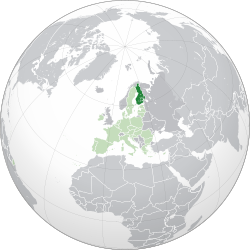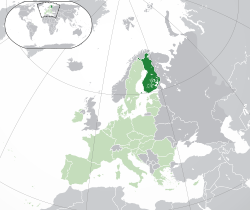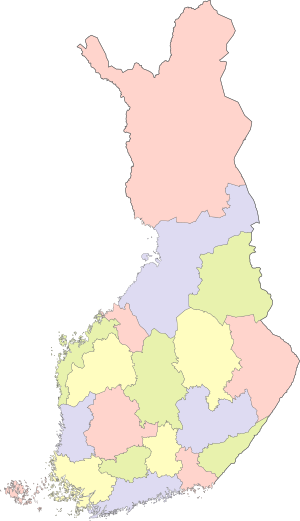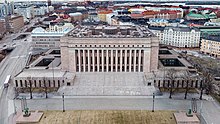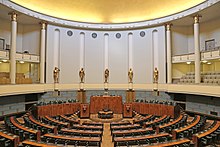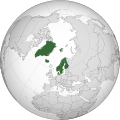Finland
Republic of Finland | |
|---|---|
| Anthem: Maamme (Finnish) Vårt land (Swedish) (English: "Our Land") | |
Location of Finland (dark green) – in Europe (green & dark grey) | |
| Capital and largest city | Helsinki 60°10′15″N 24°56′15″E / 60.17083°N 24.93750°E |
| Official languages | |
| Recognized national languages | |
| Ethnic groups (2023)[1] | |
| Religion (2023)[1] |
|
| Demonym(s) | |
| Government | Unitary parliamentary republic[2] |
| Alexander Stubb | |
| Petteri Orpo | |
| Jussi Halla-aho | |
| Legislature | Parliament |
| Independence from Soviet Russia[3] | |
| 29 March 1809 (from Sweden) | |
| 6 December 1917 | |
| 17 July 1919 | |
| Area | |
• Total | 338,145[4] km2 (130,559 sq mi) (65th) |
• Water (%) | 9.71 (2015)[5] |
| Population | |
• 2023 estimate | |
• Density | 18.4/km2 (47.7/sq mi) (213th) |
| GDP (PPP) | 2024 estimate |
• Total | |
• Per capita | |
| GDP (nominal) | 2024 estimate |
• Total | |
• Per capita | |
| Gini (2023) | low inequality |
| HDI (2022) | very high (12th) |
| Currency | Euro (€) (EUR) |
| Time zone | UTC+2 (EET) |
• Summer (DST) | UTC+3 (EEST) |
| Date format | dd.mm.yyyy[9] |
| Calling code | +358 |
| ISO 3166 code | FI |
| Internet TLD | .fi, .axa, .eub |
Finland,[a] officially the Republic of Finland,[b][c] is a Nordic country in Northern Europe. It borders Sweden to the northwest, Norway to the north, and Russia to the east, with the Gulf of Bothnia to the west and the Gulf of Finland to the south, opposite Estonia. Finland covers a total area of 338,145 square kilometres (130,559 sq mi), including a land area of 303,815 square kilometres (117,304 sq mi),[4] and has a population of 5.6 million.[10] Helsinki is the capital and largest city. The vast majority of the population are ethnic Finns. The official languages are Finnish and Swedish; 84.9 percent of the population speak the first as their mother tongue and 5.1 percent the latter.[1][11] Finland's climate varies from humid continental in the south to boreal in the north. The land cover is predominantly boreal forest biome, with more than 180,000 recorded lakes.[12][13]
Finland was first settled around 9000 BC after the last Ice Age.[14] During the Stone Age, various cultures emerged, distinguished by different styles of ceramics. The Bronze Age and Iron Ages were marked by contacts with other cultures in Fennoscandia and the Baltic region.[15] From the late 13th century, Finland became part of Sweden as a result of the Northern Crusades. In 1809, as a result of the Finnish War, Finland was captured from Sweden and became an autonomous grand duchy within the Russian Empire. During this period, Finnish art flourished and the independence movement began to take hold. Finland became the first territory in Europe to grant universal suffrage in 1906, and the first in the world to give all adult citizens the right to run for public office.[16][note 2] Following the Russian Revolution of 1917, Finland declared its independence. A civil war was fought in Finland the following year, with the Whites emerging victorious. Finland's status as a republic was confirmed in 1919. During World War II, Finland fought against the Soviet Union in the Winter War and the Continuation War, and later against Nazi Germany in the Lapland War. As a result, it lost parts of its territory to the Soviet Union but retained its independence and democracy.
Finland remained a largely agricultural country until the 1950s. After World War II, it industrialised quickly and established an advanced economy, with a welfare state built on the Nordic model. This allowed the country to experience overall prosperity and high per capita income.[17] During the Cold War, Finland officially embraced a policy of neutrality. Since then, it has become a member of the European Union in 1995, the Eurozone in 1999, and following the Russian invasion of Ukraine, joined NATO in 2023. Finland is a member of various international organisations, such as the Nordic Council, the Schengen Area, and the Organisation for Economic Co-operation and Development (OECD). The nation performs extremely well in national performance metrics, including education, economic competitiveness, civil liberties, quality of life, and human development.[18][19][20][21]
History
Prehistory
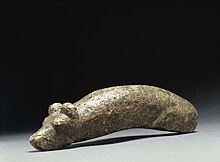
The area that is now Finland was settled in, at the latest, around 8,500 BC during the Stone Age towards the end of the last glacial period. The artefacts the first settlers left behind present characteristics that are shared with those found in Estonia, Russia, and Norway.[24] The earliest people were hunter-gatherers, using stone tools.[25]
The first pottery appeared in 5200 BC, when the Comb Ceramic culture was introduced.[26] The area of present-day Finland was in the western limits of the culture, which produced pottery with a distinct comb pattern.[27] The arrival of the Corded Ware culture in the south of coastal Finland between 3000 and 2500 BC may have coincided with the start of agriculture.[28] Even with the introduction of agriculture, hunting and fishing continued to be important parts of the subsistence economy.
In the Bronze Age, permanent all-year-round cultivation and animal husbandry spread, but the cold climate slowed the change.[29] The Seima-Turbino phenomenon brought the first bronze artefacts to the region and possibly also the Finno-Ugric languages.[29][30] Commercial contacts that had so far mostly been to Estonia started to extend to Scandinavia. Domestic manufacture of bronze artefacts started 1300 BC.[31]
In the Iron Age, population grew. Finland Proper was the most densely populated area. Commercial contacts in the Baltic Sea region grew and extended during the eighth and ninth centuries. Main exports from Finland were furs, slaves, castoreum, and falcons to European courts. Imports included silk and other fabrics, jewelry, Ulfberht swords, and, in lesser extent, glass. Production of iron started approximately in 500 BC.[32] At the end of the ninth century, indigenous artefact culture, especially weapons and women's jewelry, had more common local features than ever before. This has been interpreted to be expressing common Finnish identity.[33]
An early form of Finnic languages spread to the Baltic Sea region approximately 1900 BC. Common Finnic language was spoken around Gulf of Finland 2000 years ago. The dialects from which the modern-day Finnish language was developed came into existence during the Iron Age.[34] Contacts with the ancient Baltic and eastern Germanic peoples greatly influenced the Proto-Finnic language.[27] Although distantly related, the Sami people retained the hunter-gatherer lifestyle longer than the Finns. The Sami cultural identity and the Sami language have survived in Lapland, the northernmost province.
The name Suomi (Finnish for 'Finland') has uncertain origins, but a common etymology with saame (the Sami) has been suggested.[35][36] In the earliest historical sources, from the 12th and 13th centuries, the term Finland refers to the coastal region around Turku. This region later became known as Finland Proper in distinction from the country name Finland.[37]
Swedish era
The 12th and 13th centuries were a violent time in the northern Baltic Sea. The Livonian Crusade was ongoing and the Finnish tribes such as the Tavastians and Karelians were in frequent conflicts with Novgorod and with each other. Also, during the 12th and 13th centuries several crusades from the Catholic realms of the Baltic Sea area were made against the Finnish tribes. Danes waged at least three crusades to Finland, in 1187 or slightly earlier,[38] in 1191 and in 1202,[39] and Swedes, possibly the so-called second Crusade to Finland, in 1249 against Tavastians and the third Crusade to Finland in 1293 against the Karelians. The so-called first Crusade to Finland, possibly in 1155, most likely never occurred.[40]
As a result of the Crusades, mostly with the Second Swedish Crusade led by Birger Jarl, and the colonization of some Finnish coastal areas with Christian Swedes during the Middle Ages,[41] Finland gradually became part of the kingdom of Sweden and the sphere of influence of the Catholic Church.[42] Under Sweden, Finland was annexed as part of the cultural order of Western Europe.[43] The Swedes built fortresses in Häme and Turku, while a Swedish royal council was instituted, an administrative structure and fiscal apparatus was created, and law codes were codified during the reigns of Magnus Ladulås (1275–1290) and Magnus Eriksson (1319–1364).[44] As a result, the Finnish lands were firmly integrated into the Swedish realm.[44]

Swedish was the dominant language of the nobility, administration, and education; Finnish was chiefly a language for the peasantry, clergy, and local courts in predominantly Finnish-speaking areas.[45][46] During the Protestant Reformation, the Finns gradually converted to Lutheranism.[47] The end of the Kalmar Union ushered in an era of religious, social, and economic changes.[48] Gustav Vasa (r. 1523–1560) made his second son Johan the duke of Finland, while Gustav Adolf (r. 1611–1632) created the office of governor-general for Finland as part of his restructuring of the administration of the Swedish realm.[49]
In the 16th century, a bishop and Lutheran Reformer Mikael Agricola published the first written works in Finnish;[50] and Finland's current capital city, Helsinki, was founded by King Gustav Vasa in 1555.[51] The first university in Finland, the Royal Academy of Turku, was established by Queen Christina of Sweden at the proposal of Count Per Brahe in 1640.[52][53]
The Finns reaped a reputation in the Thirty Years' War (1618–1648) as a well-trained cavalrymen called "Hakkapeliitta".[54] Finland suffered a severe famine in 1695–1697, during which about one third of the Finnish population died,[55] and a devastating plague a few years later.
In the 18th century, wars between Sweden and Russia twice led to the occupation of Finland by Russian forces, times known to the Finns as the Greater Wrath (1714–1721) and the Lesser Wrath (1742–1743).[56][55] It is estimated that almost an entire generation of young men was lost during the Great Wrath, due mainly to the destruction of homes and farms, and the burning of Helsinki.[57]
Grand Duchy of Finland
The Swedish era ended with the Finnish War of 1809. On 29 March 1809, after being conquered by the armies of Alexander I of Russia, Finland became an autonomous grand duchy within the Russian Empire, as recognised by the Diet of Porvoo.[58] This situation continued until the end of 1917.[56] In 1812, Alexander I incorporated the Russian province of Vyborg into the Grand Duchy of Finland. In 1854, Finland became involved in Russia's involvement in the Crimean War when the British and French navies bombed the Finnish coast and Åland during the so-called Åland War.[59]

Although Swedish was still widely spoken, the Finnish language began to gain recognition during this period. From the 1860s, a strong Finnish nationalist movement, known as the Fennoman movement, grew. One of the movement's most prominent leaders was the philosopher and politician J.V. Snellman, who worked to stabilise the status of the Finnish language and its own currency, the Finnish markka, in the Grand Duchy of Finland.[59][60] Milestones included the publication of what would become Finland's national epic, the Kalevala, in 1835 and the legal equality of the Finnish language with Swedish in 1892. In the spirit of Adolf Ivar Arwidsson - "we are not Swedes, we do not want to become Russians, so let us be Finns" - a Finnish national identity was established.[61] Nevertheless, there was no real independence movement in Finland until the early 20th century.[62]
The Finnish famine of 1866–1868 occurred after freezing temperatures in early September devastated crops and killed around 15% of the population, making it one of the worst famines in European history.[63] The famine led the Russian Empire to relax financial regulations, and investment increased in the following decades. Economic development was rapid.[64] The gross domestic product (GDP) per capita was still half of that of the United States and a third of that of Britain.[64]
From 1869 to 1917, the Russian Empire pursued a policy of Russification, which was suspended between 1905 and 1908. In 1906, universal suffrage was introduced in the Grand Duchy of Finland. However, relations between the Grand Duchy of Finland and the Russian Empire soured when the Russian government began to take steps to restrict Finland's special status and autonomy. For example, universal suffrage was virtually meaningless in practice, as the tsar did not have to approve any of the laws passed by the Finnish parliament. The desire for independence gained ground, first among radical liberals[65] and socialists, partly driven by a declaration called the February Manifesto by the last tsar of the Russian Empire, Nicholas II, on 15 February 1899.[66]
Civil war and early independence
After the February Revolution of 1917, Finland's position as a Grand Duchy under the rule of the Russian Empire was questioned. The Finnish parliament, controlled by the Social Democrats, passed the so-called Power Act to give the parliament supreme authority. This was rejected by the Russian Provisional Government, which decided to dissolve the parliament.[67] New elections were held in which the right-wing parties won by a small majority. Some social democrats refused to accept the result, claiming that the dissolution of parliament and the subsequent elections were extra-legal. The two almost equally powerful political blocs, the right-wing parties and the Social Democratic Party, were deeply divided.

The October Revolution in Russia changed the geopolitical situation once again. Suddenly the right-wing parties in Finland began to reconsider their decision to block the transfer of supreme executive power from the Russian government to Finland when the Bolsheviks came to power in Russia. The right-wing government, led by Prime Minister P. E. Svinhufvud, presented the Declaration of Independence on 4 December 1917, which was officially approved by the Finnish Parliament on 6 December. The Russian Soviet Federative Socialist Republic (RSFSR), led by Vladimir Lenin was the first country to recognise Finland's independence on 4 January 1918.[68]
On 27 January 1918, the government began to disarm the Russian forces in Ostrobothnia. The socialists took control of southern Finland and Helsinki, but the white government continued in exile in Vaasa.[69][70] This led to a short but bitter civil war. The Whites, backed by Imperial Germany, prevailed over the Reds[71] and their self-proclaimed Finnish Socialist Workers' Republic.[72] After the war, tens of thousands of Reds were interned in camps where thousands were executed or died of malnutrition and disease. A deep social and political enmity was sown between the Reds and the Whites that would last until the Winter War and beyond.[73][74] The civil war and the activist expeditions to Soviet Russia in 1918–1920, known as the "Kinship Wars", strained relations with the East.[75][76]
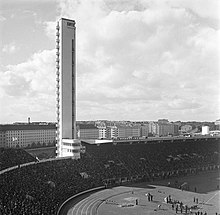
After a brief experiment with monarchy, when an attempt to make Prince Frederick Charles of Hesse the king of Finland failed, a republican constitution was adopted and Finland became a presidential republic, with K. J. Ståhlberg elected as its first president on 25 July 1919.[77] A liberal nationalist with a legal background, Ståhlberg anchored the state in liberal democracy, promoted the rule of law and initiated internal reforms.[78] Finland was also one of the first European countries to strongly promote women's equality, with Miina Sillanpää becoming the first female minister in Finnish history in Väinö Tanner's cabinet in 1926–1927.[79] The Finnish-Russian border was established in 1920 by the Treaty of Tartu, which largely followed the historical border but gave Finland Pechenga (Finnish: Petsamo) and its Barents Sea port.[56] Finnish democracy survived Soviet coup attempts and the anti-communist Lapua movement.
In 1917 there were three million people in the country. After the civil war, a credit-based land reform was introduced, increasing the proportion of the population with access to capital.[64] About 70% of the workforce was employed in agriculture and 10% in industry.[80]
World War II
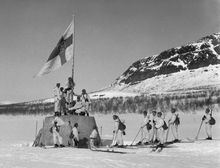
The Soviet Union launched the Winter War on 30 November 1939 to annex Finland in accordance with the Molotov-Ribbentrop Pact with Nazi Germany to divide Europe into spheres of influence between the two dictatorships.[81][82] The Finnish Democratic Republic was set up by Joseph Stalin at the beginning of the war to govern Finland after Soviet conquest.[83] There was widespread international condemnation of the unprovoked attack and it led to the Soviet Union being expelled from the League of Nations.[84] The Red Army was defeated in numerous battles, most notably the Battle of Suomussalmi. After two months of negligible progress on the battlefield, as well as heavy losses in men and material,[85] Soviet forces began to advance in February and reached Vyborg (Finnish: Viipuri) in March. The Moscow Peace Treaty was signed on 12 March 1940, and the war ended the following day. Finland had defended its independence, but ceded 9% of its territory to the Soviet Union.

Hostilities resumed in June 1941 with the Continuation War, when Finland allied itself with Germany following the latter's invasion of the Soviet Union; the main aim was to regain the territory lost to the Soviets barely a year earlier.[86] Finnish troops occupied Eastern Karelia from 1941 to 1944. The massive Soviet Vyborg-Petrozavodsk offensive in the summer of 1944 led to a breakthrough until the Finns finally repulsed it at Tali-Ihantala. This partial Soviet success led to a stalemate and later an armistice. This was followed by the Lapland War of 1944–1945, when Finland fought retreating German forces in northern Finland.
The Armistice and treaty signed with the Soviet Union in 1944 and 1948 included Finnish obligations, restraints, and reparations, as well as further territorial concessions. As a result of the two wars, Finland lost 12% of its land area, 20% of its industrial capacity, its second largest city, Vyborg (Finnish: Viipuri), and the ice-free port of Liinakhamari (Finnish: Liinahamari). The Finns lost 97,000 soldiers and were forced to pay war reparations of $300 million ($4.1 billion in 2023). However, the country avoided occupation by Soviet forces and managed to retain its independence. Along with Great Britain, Finland emerged from the war as the only European country to have taken part in hostilities that was never occupied and managed to preserve its democracy throughout.[87]
For a few decades after 1944, the Communists were a strong political party. Furthermore, the Soviet Union persuaded Finland to refuse Marshall Plan aid. However, in the hope of preserving Finland's independence, the United States provided secret development aid and supported the Social Democratic Party.[88]
After the war
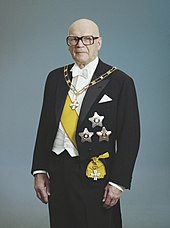
The development of trade with the Western powers, such as the United Kingdom, and the payment of reparations to the Soviet Union led to Finland's transformation from a primarily agrarian society to an industrialised one. Valmet, originally a shipyard and then several metal workshops, was established to produce materials for war reparations. After the reparations were paid, Finland continued to trade with the Soviet Union as part of bilateral trade.
In 1950, 46% of Finnish workers were employed in agriculture and a third lived in urban areas, but new jobs in manufacturing, services and trade quickly attracted people to the cities.[89] The average number of births per woman fell from a baby boom peak of 3.5 in 1947 to 1.5 in 1973. As the baby boomers entered the workforce, the economy failed to create jobs fast enough and hundreds of thousands emigrated to more industrialised Sweden, with emigration peaking in 1969 and 1970.[89] Finland participated in trade liberalisation in the World Bank, the International Monetary Fund and the General Agreement on Tariffs and Trade.
During the Cold War, Finland officially embraced a policy of neutrality. The YYA treaty (Finno-Soviet Pact of Friendship, Cooperation and Mutual Assistance) recognized Finland's desire to remain outside great-power conflicts. From 1956 president Urho Kekkonen had a virtual monopoly on relations with the Soviet Union, which was crucial to his continued popularity. In politics, there was a tendency to avoid any policy or statement that could be interpreted as anti-Soviet. This phenomenon was dubbed "Finlandisation" by the West German press.[90]

A market economy was maintained in Finland. Various industries benefited from trade privileges with the Soviets. Economic growth was rapid in the post-war period, and by 1975 Finland's GDP per capita was the 15th highest in the world. During the 1970s and 1980s, Finland built one of the most extensive welfare states in the world. Finland negotiated a treaty with the European Economic Community (EEC, a forerunner of the European Union) that largely eliminated tariffs with the EEC from 1977.
Miscalculated macroeconomic decisions, a banking crisis, the collapse of its largest trading partner, the Soviet Union, and a global economic downturn caused a deep recession in Finland in the early 1990s. The recession bottomed out in 1993 and Finland enjoyed more than a decade of steady economic growth.[91] After the collapse of the Soviet Union, Finland began to integrate more closely with the West.[92] Finland joined the European Union in 1995 and the euro zone in 1999. Much of the economic growth of the late 1990s was fuelled by the success of mobile phone manufacturer Nokia.[43]
21st century
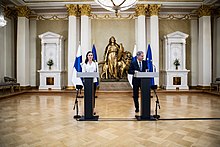
The Finnish people elected Tarja Halonen in the 2000 Presidential election, making her the first female President of Finland.[93] Her predecessor, President Martti Ahtisaari, later won the Nobel Peace Prize in 2008. Financial crises paralysed Finland's exports in 2008, leading to weaker economic growth throughout the decade.[94][95] Sauli Niinistö was elected President of Finland from 2012 until 2024, when Alexander Stubb took over.[96][97]
Finnish support for NATO rose sharply after the Russian invasion of Ukraine in 2022. Before February 2022, opinion polls showed a narrow but decisive majority against NATO membership;[98] by April, a supermajority was in favour of membership.[99][100][101][102] On 11 May 2022, Finland signed a mutual security pact with the United Kingdom.[103] On 12 May, Finland's president and Prime Minister called for NATO membership "without delay".[104] Subsequently, on 17 May, the Finnish Parliament voted 188–8 in favour of Finland's accession to NATO.[105] Finland became a member of NATO on 4 April 2023.[106]
Geography

Lying approximately between latitudes 60° and 70° N, and longitudes 20° and 32° E, Finland is one of the world's northernmost countries. Of world capitals, only Reykjavík lies more to the north than Helsinki. The distance from the southernmost point – Hanko in Uusimaa – to the northernmost – Nuorgam in Lapland – is 1,160 kilometres (720 mi).
Finland has about 168,000 lakes (of area larger than 500 m2 or 0.12 acres) and 179,000 islands.[107] Its largest lake, Saimaa, is the fourth largest in Europe. The Finnish Lakeland is the area with the most lakes in the country;[13] many of the major cities in the area, most notably Tampere, Jyväskylä and Kuopio, are located near the large lakes. The Finnish coastline is speckled with the world's largest archipelago, encompassing more than 50,000 islands, greatest concentration of which is found in the southwest, in the Archipelago Sea between continental Finland and the main island of Åland.[108]
Much of the geography of Finland is a result of the Ice Age. The glaciers were thicker and lasted longer in Fennoscandia compared with the rest of Europe. The eroding effects have contributed to a mostly flat landscape in Finland, characterized by hills. However, in the northern regions, including areas bordering the Scandinavian Mountains, the terrain features mountainous elevations. At 1,324 metres (4,344 ft), Halti is the highest point in Finland. It is found in the north of Lapland at the border between Finland and Norway. The highest mountain whose peak is entirely in Finland is Ridnitšohkka at 1,316 m (4,318 ft), directly adjacent to Halti.

The retreating glaciers have left the land with morainic deposits in formations of eskers. These are ridges of stratified gravel and sand, running northwest to southeast, where the ancient edge of the glacier once lay. Among the biggest of these are the three Salpausselkä ridges that run across southern Finland.
Having been compressed under the enormous weight of the glaciers, terrain in Finland is rising due to the post-glacial rebound. The effect is strongest around the Gulf of Bothnia, where land steadily rises about 1 cm (0.4 in) a year. As a result, the old sea bottom turns little by little into dry land: the surface area of the country is expanding by about 7 square kilometres (2.7 sq mi) annually.[109] Relatively speaking, Finland is rising from the sea.[110]
The landscape is covered mostly by coniferous taiga forests and fens, with little cultivated land. Of the total area, 10% is lakes, rivers, and ponds, and 78% is forest. The forest consists of pine, spruce, birch, and other species.[111] Finland is the largest producer of wood in Europe and among the largest in the world. The most common type of rock is granite. It is a ubiquitous part of the scenery, visible wherever there is no soil cover. Moraine or till is the most common type of soil, covered by a thin layer of humus of biological origin. Podzol profile development is seen in most forest soils except where drainage is poor. Gleysols and peat bogs occupy poorly drained areas.
Biodiversity


Phytogeographically, Finland is shared between the Arctic, central European, and northern European provinces of the Circumboreal Region within the Boreal Kingdom. According to the WWF, the territory of Finland can be subdivided into three ecoregions: the Scandinavian and Russian taiga, Sarmatic mixed forests, and Scandinavian Montane Birch forest and grasslands.[113] Taiga covers most of Finland from northern regions of southern provinces to the north of Lapland. On the southwestern coast, south of the Helsinki-Rauma line, forests are characterized by mixed forests, that are more typical in the Baltic region. In the extreme north of Finland, near the tree line and Arctic Ocean, Montane Birch forests are common. Finland had a 2018 Forest Landscape Integrity Index mean score of 5.08/10, ranking it 109th globally out of 172 countries.[114]
Similarly, Finland has a diverse and extensive range of fauna. There are at least sixty native mammalian species, 248 breeding bird species, over 70 fish species, and 11 reptile and frog species present today, many migrating from neighbouring countries thousands of years ago. Large and widely recognized wildlife mammals found in Finland are the brown bear, grey wolf, wolverine, and elk. Three of the more striking birds are the whooper swan, a large European swan and the national bird of Finland; the Western capercaillie, a large, black-plumaged member of the grouse family; and the Eurasian eagle-owl. The latter is considered an indicator of old-growth forest connectivity, and has been declining because of landscape fragmentation.[115] Around 24,000 species of insects are prevalent in Finland some of the most common being hornets with tribes of beetles such as the Onciderini also being common. The most common breeding birds are the willow warbler, common chaffinch, and redwing.[116] Of some seventy species of freshwater fish, the northern pike, perch, and others are plentiful. Atlantic salmon remains the favourite of fly rod enthusiasts.
The endangered Saimaa ringed seal, one of only three lake seal species in the world, exists only in the Saimaa lake system of southeastern Finland, down to only 390 seals today.[117][118] The species has become the emblem of the Finnish Association for Nature Conservation.[119]
A third of Finland's land area originally consisted of moorland, about half of this area has been drained for cultivation over the past centuries.[120]
Climate

The main factor influencing Finland's climate is the country's geographical position between the 60th and 70th northern parallels in the Eurasian continent's coastal zone. In the Köppen climate classification, the whole of Finland lies in the boreal zone, characterized by warm summers and freezing winters. Within the country, the temperateness varies considerably between the southern coastal regions and the extreme north, showing characteristics of both a maritime and a continental climate. Finland is near enough to the Atlantic Ocean to be continuously warmed by the Gulf Stream. The Gulf Stream combines with the moderating effects of the Baltic Sea and numerous inland lakes to explain the unusually warm climate compared with other regions that share the same latitude, such as Alaska, Siberia, and southern Greenland.[121]

Winters in southern Finland (when mean daily temperature remains below 0 °C or 32 °F) are usually about 100 days long, and in the inland the snow typically covers the land from about late November to April, and on the coastal areas such as Helsinki, snow often covers the land from late December to late March.[122] Even in the south, the harshest winter nights can see the temperatures fall to −30 °C (−22 °F) although on coastal areas like Helsinki, temperatures below −30 °C (−22 °F) are rare. Climatic summers (when mean daily temperature remains above 10 °C or 50 °F) in southern Finland last from about late May to mid-September, and in the inland, the warmest days of July can reach over 35 °C (95 °F).[121] Although most of Finland lies on the taiga belt, the southernmost coastal regions are sometimes classified as hemiboreal.[123]
In northern Finland, particularly in Lapland, the winters are long and cold, while the summers are relatively warm but short. On the most severe winter days in Lapland can see the temperature fall to −45 °C (−49 °F). The winter of the north lasts for about 200 days with permanent snow cover from about mid-October to early May. Summers in the north are quite short, only two to three months, but can still see maximum daily temperatures above 25 °C (77 °F) during heat waves.[121] No part of Finland has Arctic tundra, but Alpine tundra can be found at the fells Lapland.[123]
The Finnish climate is suitable for cereal farming only in the southernmost regions, while the northern regions are suitable for animal husbandry.[124]
A quarter of Finland's territory lies within the Arctic Circle and the midnight sun can be experienced for more days the farther north one travels. At Finland's northernmost point, the sun does not set for 73 consecutive days during summer and does not rise at all for 51 days during winter.[121]
Finland is ranked 4th in Environmental Performance Index for year 2024.[125] This Index combines various indicators around known issues around the world and measures how good they fit in among each countries on a scale. Finland scores good in parameters like Climate Change Mitigation, Waste Management, Air pollution, Air quality etc.[126]
Regions
Finland consists of 19 regions (maakunta). The counties are governed by regional councils which serve as forums of cooperation for the municipalities of a county. The main tasks of the counties are regional planning and development of enterprise and education. In addition, the public health services are usually organized based on counties. Regional councils are elected by municipal councils, each municipality sending representatives in proportion to its population. In addition to inter-municipal cooperation, which is the responsibility of regional councils, each county has a state Employment and Economic Development Centre which is responsible for the local administration of labour, agriculture, fisheries, forestry, and entrepreneurial affairs. Historically, counties are divisions of historical provinces of Finland, areas that represent local dialects and culture more accurately.
Six Regional State Administrative Agencies are responsible for one of the counties called alue in Finnish; in addition, Åland was designated a seventh county.[127]
|
The county of Eastern Uusimaa (Itä-Uusimaa) was consolidated with Uusimaa on 1 January 2011.[129]
Administrative divisions
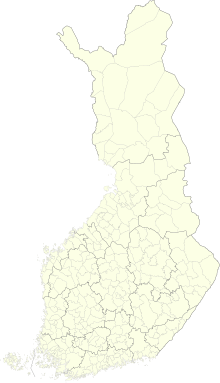
The fundamental administrative divisions of the country are the municipalities, which may also call themselves towns or cities. They account for half of the public spending. Spending is financed by municipal income tax, state subsidies, and other revenue. As of 2021[update], there are 309 municipalities,[130] and most have fewer than 6,000 residents.
In addition to municipalities, two intermediate levels are defined. Municipalities co-operate in seventy sub-regions and nineteen counties. These are governed by the member municipalities and have only limited powers. The autonomous province of Åland has a permanent democratically elected regional council. Sami people have a semi-autonomous Sami native region in Lapland for issues on language and culture.
Health, social and emergency services are organised by the Wellbeing services counties. Finland has 21 Wellbeing services counties and the county structure is mainly based on the region structure. The County council, which is responsible for the operation, administration and finances of the area, is the highest decision-making body in the Wellbeing services county. The delegates and deputy commissioners of the county council are elected in the county elections for a term of office of four years. Wellbeing services counties are self-governing. However, they do not have the right to levy taxes and their funding is based on central government funding.[131]
The capital region – comprising Helsinki, Vantaa, Espoo and Kauniainen – forms a continuous conurbation of approximately 1.27 million people. However, common administration is limited to voluntary cooperation of all municipalities, e.g. in Helsinki Metropolitan Area Council.
Government and politics
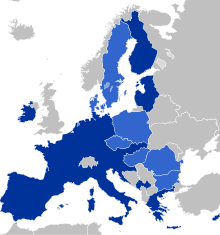
the Eurozone the European Union
Constitution
The Constitution of Finland defines the political system; Finland is a parliamentary republic within the framework of a representative democracy. The Prime Minister is the country's most powerful person. Citizens can run and vote in parliamentary, municipal, presidential, and European Union elections.
President
Finland's head of state is the President of the Republic. Finland had, for most of its independence a semi-presidential system of government, but in the last few decades the powers of the president have become more circumscribed, and consequently the country is now considered a parliamentary republic.[2] A new constitution, enacted in 2000, made the presidency primarily a ceremonial office. The president appoints the prime minister as elected by Parliament, appoints and dismisses the other ministers of the Finnish Government on the recommendation of the prime minister, opens parliamentary sessions, and confers state honors. Nevertheless, the president remains responsible for Finland's foreign relations, including the making of war and peace, but excluding matters related to the European Union.[citation needed] Moreover, the president exercises supreme command over the Finnish Defence Forces as commander-in-chief. In the exercise of his or her foreign and defense powers, the president is required to consult the Finnish government, but the government's advice is not binding. In addition, the president has several domestic reserve powers, including the authority to veto legislation, to grant pardons, and to appoint several public officials.[citation needed] The president is also required by the Constitution to dismiss individual ministers or the entire government upon a parliamentary vote of no confidence.[132]
The president is directly elected via runoff voting and may serve for a maximum of two consecutive 6-year terms. The current president is Alexander Stubb, who took office on 1 March 2024. His predecessors were Kaarlo Juho Ståhlberg (1919–1925), Lauri Kristian Relander (1925–1931), Pehr Evind Svinhufvud (1931–1937), Kyösti Kallio (1937–1940), Risto Ryti (1940–1944), Carl Gustaf Emil Mannerheim (1944–1946), Juho Kusti Paasikivi (1946–1956), Urho Kekkonen (1956–1982), Mauno Koivisto (1982–1994), Martti Ahtisaari (1994–2000), Tarja Halonen (2000–2012), and Sauli Niinistö (2012–2024).
Parliament
The 200-member unicameral Parliament of Finland (Finnish: Eduskunta) exercises supreme legislative authority in the country. It may alter the constitution and ordinary laws, dismiss the cabinet, and override presidential vetoes. Its acts are not subject to judicial review; the constitutionality of new laws is assessed by the parliament's constitutional law committee. The parliament is elected for a term of four years using the proportional D'Hondt method within several multi-seat constituencies through the most open list multi-member districts. Various parliament committees listen to experts and prepare legislation.
Significant parliamentary parties are Centre Party, Christian Democrats, Finns Party, Green League, Left Alliance, National Coalition Party, Social Democrats and Swedish People's Party.
Cabinet
After parliamentary elections, the parties negotiate among themselves on forming a new cabinet (the Finnish Government), which then has to be approved by a simple majority vote in the parliament. The cabinet can be dismissed by a parliamentary vote of no confidence, although this rarely happens, as the parties represented in the cabinet usually make up a majority in the parliament.
The cabinet exercises most executive powers and originates most of the bills that the parliament then debates and votes on. It is headed by the Prime Minister of Finland, and consists of him or her, other ministers, and the Chancellor of Justice. Each minister heads his or her ministry, or, in some cases, has responsibility for a subset of a ministry's policy. After the prime minister, the most powerful minister is often the minister of finance.
As no one party ever dominates the parliament, Finnish cabinets are multi-party coalitions. As a rule, the post of prime minister goes to the leader of the biggest party and that of the minister of finance to the leader of the second biggest.
The Orpo Cabinet is the incumbent 77th government of Finland. It took office on 20 June 2023. The cabinet is headed by Petteri Orpo and is a coalition between the National Coalition Party, Finns Party, the Swedish People's Party, and the Christian Democrats.[133]
Law
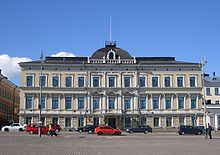
The judicial system of Finland is a civil law system divided between courts with regular civil and criminal jurisdiction and administrative courts with jurisdiction over litigation between individuals and the public administration. Finnish law is codified and based on Swedish law and in a wider sense, civil law or Roman law. The court system for civil and criminal jurisdiction consists of local courts, regional appellate courts, and the Supreme Court. The administrative branch of justice consists of administrative courts and the Supreme Administrative Court. In addition to the regular courts, there are a few special courts in certain branches of administration. There is also a High Court of Impeachment for criminal charges against certain high-ranking officeholders.
Around 92% of residents have confidence in Finland's security institutions.[134] The overall crime rate of Finland is not high in the EU context. Some crime types are above average, notably the high homicide rate for Western Europe.[135] A day fine system is in effect and also applied to offenses such as speeding. Finland has a very low number of corruption charges; Transparency International ranks Finland as one of the least corrupt countries in Europe.
Foreign relations
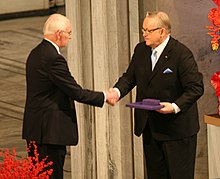
According to the 2012 constitution, the president leads foreign policy in cooperation with the government, except that the president has no role in EU affairs.[136] In 2008, president Martti Ahtisaari was awarded the Nobel Peace Prize.[137]
Finland's relationship with Russia deteriorated following the 2022 Russian invasion of Ukraine, with a number of Russian diplomats expelled for spying, Russians restricted from visiting Finland and the general opinion immediately changing for Finland to join NATO,[138] while it has also had a significant impact on the increasing strengthold of relations between the United States and Finland.[139] According to the 2024 Global Peace Index, Finland is the 13th most peaceful country in the world.[140]
Military
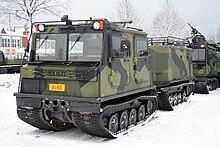
The Finnish Defence Forces consist of a cadre of professional soldiers (mainly officers and technical personnel), currently serving conscripts, and a large reserve. The standard readiness strength is 34,700 people in uniform, of which 25% are professional soldiers. A universal male conscription is in place, under which all male Finnish nationals above 18 years of age serve for 6 to 12 months of armed service or 12 months of civilian (non-armed) service. Voluntary post-conscription overseas peacekeeping service is popular, and troops serve around the world in UN, NATO, and EU missions. Women are allowed to serve in all combat arms. In 2022, 1211 women entered voluntary military service.[141] The army consists of a highly mobile field army backed up by local defence units. With a high capability of military personnel,[142] arsenal[143] and homeland defence willingness, Finland is one of Europe's militarily strongest countries.[144]
Finnish defence expenditure per capita is one of the highest in the European Union.[145] The branches of the military are the army, the navy, and the air force. The border guard is under the Ministry of the Interior but can be incorporated into the Defence Forces when required for defence readiness.
Finland became a member of NATO on 4 April 2023,[106] though it participated in the NATO Response Force before becoming a member. Before NATO membership, Finland has been part of the Joint Expeditionary Force (JEF) since 2017.[146] Finland also contributes to the EU Battlegroup.[147][148][149] Finland sent personnel to the Kosovo Force and the International Security Assistance Force in Afghanistan.[150][151] On 18 December 2023, Finland signed the DCA agreement with the United States, which regulates the presence of the US armed forces and their dependents on the territory of Finland, as well as the presence and activities of US suppliers.[152]
Human rights

Finland has one of the world's most extensive welfare systems, one that guarantees decent living conditions for all residents. The welfare system was created almost entirely during the first three decades after World War II.[153]
Section 6 of the Finnish Constitution states: "No one shall be placed in a different position on situation of sex, age, origin, language, religion, belief, opinion, state of health, disability or any other personal reason without an acceptable reason".[154]
Finland has been ranked above average among the world's countries in democracy,[155] press freedom,[156] and human development.[157] Amnesty International has expressed concern regarding some issues in Finland, such as the imprisonment of conscientious objectors, and societal discrimination against Romani people and members of other ethnic and linguistic minorities.[158][159]
In the report of the European umbrella organization ILGA-Europe published in May 2023, Finland ranked sixth in a European comparison of LGBTQ+ rights.[160]
Economy
As of 2022[update], Finland ranks 16th globally in nominal GDP per capita according to the IMF. Additionally, Finland boasts a well-developed welfare system that encompasses free education and universal healthcare, contributing to its reputation as one of the wealthiest nations.
The service sector constitutes the largest segment of the economy, amounting to 66% of the GDP, while manufacturing and refining make up 31%. Primary production accounts for 2.9% of the economy.[161] Manufacturing is the primary economic sector concerning foreign trade.[162] The predominant industrial sectors in 2007 were electronics (22%), machinery, vehicles, and other engineered metal products (21.1%), forest industry (13%), and chemicals (11%). The gross domestic product reached its peak in 2021.[163] Finland has been ranked seventh in the Global Innovation Index of 2023 and 2024.[164]

Finland has considerable timber, mineral (including iron, chromium, copper, nickel and gold) and freshwater resources. Finland's gold production in 2015 was 9 metric tons.[167] For the rural population, forestry, paper mills and agriculture are important. The Helsinki metropolitan area area accounts for roughly one-third of Finland's GDP. Private services represent the largest employer in Finland.
Finland's soil and climate pose particular challenges for crop production, with harsh winters and relatively short growing seasons, often interrupted by frost. However, the prevalence of the Gulf Stream and the North Atlantic Drift Current in Finland's temperate climate allows for half of the world's arable land north of the 60° north latitude. Although annual precipitation is generally adequate, it mostly transpires during winter, which poses a continuous risk of summer droughts. Farmers have adapted to the climate by relying on quick-ripening and frost-resistant crop varieties. They cultivate south-facing slopes and rich bottomlands to ensure year-round production, even during summer frosts. Drainage systems are often utilized to remove excess water. Finland's agricultural sector has demonstrated remarkable efficiency and productivity, particularly in comparison to its European counterparts.[153]
Forests are crucial to the nation's economy, making it one of the world's foremost wood producers and offering raw materials at competitive prices to the wood processing industries. The government has played an important role in forestry for a considerable period similar to that in agriculture. It has regulated tree cutting, sponsored technical improvements, and established long-term plans to guarantee the sustainability of the country's forests in supplying the wood-processing industries.[153]
As of 2008[update], the average level of income, adjusted for purchasing power, was comparable to that of Italy, Sweden, Germany and France.[168] In 2006, 62% of the labour force was employed by firms with fewer than 250 workers, which generated 49% of total business revenue.[169] The employment rate of women is high. Gender segregation between male-dominated professions and female-dominated professions is higher than in the US.[170] The proportion of part-time workers was one of the lowest in OECD in 1999.[170] As of 2013[update], the 10 largest private sector employers in Finland were Itella, Nokia, OP-Pohjola, ISS, VR, Kesko, UPM-Kymmene, YIT, Metso, and Nordea.[171] As of 2022[update], the unemployment rate was 6.8%.[172]
As of 2022[update], 46% of households consist of a single person, 32% two persons and 22% three or more persons.[173] The average residential space is 40 square metres (430 sq ft) per person.[174] In 2021, Finland's GDP reached €251 billion.[163] In 2022, altogether 74 per cent of employed persons worked in services and administration, 21 per cent in industry and construction, and four per cent in agriculture and forestry.[175]
Finland has the highest concentration of cooperatives relative to its population.[176] The largest retailer, which is also the largest private employer, S-Group, and the largest bank, OP-Group, in the country are both cooperatives.
Energy
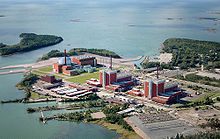
The free and largely privately owned financial and physical Nordic energy markets traded in NASDAQ OMX Commodities Europe and Nord Pool Spot exchanges, have provided competitive prices compared with other EU countries. As of 2022[update], Finland has the lowest non-household electricity prices in the EU.[178]
In 2021, the energy market was around 87 terawatt hours and the peak demand around 14 gigawatts in winter.[179][180] Industry and construction consumed 43.5% of total consumption, a relatively high figure reflecting Finland's industries.[179] Finland's hydrocarbon resources are limited to peat and wood. About 18% of the electricity is produced by hydropower[179] In 2021, renewable energy (mainly hydropower and various forms of wood energy) was high at 43% compared with the EU average of 22% in final energy consumption.[181] About 20% of electricity is imported, especially from Sweden due to its lower cost there.[182] As of February 2022[update], Finland's strategic petroleum reserves held 200 days worth of net oil imports in the case of emergencies.[183]
Finland has five privately owned nuclear reactors producing 40% of the country's energy.[177] The Onkalo spent nuclear fuel repository is currently under construction at the Olkiluoto Nuclear Power Plant in the municipality of Eurajoki, on the west coast of Finland, by the company Posiva.[184]
Transport
Finland's road system is utilized by most internal cargo and passenger traffic. The annual state operated road network expenditure of around €1 billion is paid for with vehicle and fuel taxes which amount to around €1.5 billion and €1 billion, respectively. Among the Finnish highways, the most significant and busiest main roads include the Turku Highway (E18), the Tampere Highway (E12), the Lahti Highway (E75), and the ring roads (Ring I and Ring III) of the Helsinki metropolitan area and the Tampere Ring Road of the Tampere urban area.[185]
The main international passenger gateway is Helsinki Airport, which handled about 15.3 million passengers in 2023.[186] Another 26 airports have scheduled passenger services.[187] The Helsinki Airport-based Finnair, Blue1, and Nordic Regional Airlines, Norwegian Air Shuttle sell air services both domestically and internationally.
The Government annually spends around €350 million to maintain the 5,865-kilometre-long (3,644 mi) network of railway tracks. Rail transport is handled by the state-owned VR Group.[188] Finland's first railway was opened in 1862,[189][190] and today it forms part of the Finnish Main Line, which is more than 800 kilometers long. Helsinki opened the world's northernmost metro system in 1982.
The majority of international cargo shipments are handled at ports. Vuosaari Harbour in Helsinki is the largest container port in Finland; others include Kotka, Hamina, Hanko, Pori, Rauma, and Oulu. There is passenger traffic from Helsinki and Turku, which have ferry connections to Tallinn, Mariehamn, Stockholm and Travemünde. The Helsinki-Tallinn route is one of the busiest passenger sea routes in the world.[191]
Industry

Finland rapidly industrialized after World War II, achieving GDP per capita levels comparable to that of Japan or the UK at the beginning of the 1970s. Initially, most of the economic development was based on two broad groups of export-led industries, the "metal industry" (metalliteollisuus) and "forest industry" (metsäteollisuus). The "metal industry" includes shipbuilding, metalworking, the automotive industry, engineered products such as motors and electronics, and production of metals and alloys including steel, copper and chromium. Many of the world's biggest cruise ships, including MS Freedom of the Seas and the Oasis of the Seas have been built in Finnish shipyards.[192][193] The "forest industry" includes forestry, timber, pulp and paper, and is often considered a logical development based on Finland's extensive forest resources, as 73% of the area is covered by forest. In the pulp and paper industry, many major companies are based in Finland; Ahlstrom-Munksjö, Metsä Board, and UPM are all Finnish forest-based companies with revenues exceeding €1 billion. However, in recent decades, the Finnish economy has diversified, with companies expanding into fields such as electronics (Nokia), metrology (Vaisala), petroleum (Neste), and video games (Rovio Entertainment), and is no longer dominated by the two sectors of metal and forest industry. Likewise, the structure has changed, with the service sector growing. Despite this, production for export is still more prominent than in Western Europe, thus making Finland possibly more vulnerable to global economic trends.
In 2017, the Finnish economy was estimated to consist of approximately 2.7% agriculture, 28.2% manufacturing, and 69.1% services.[194] In 2019, the per-capita income of Finland was estimated to be $48,869. In 2020, Finland was ranked 20th on the ease of doing business index, among 190 jurisdictions.
Public policy
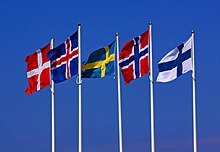
Finnish politicians have often emulated the Nordic model.[195] Nordics have been free-trading for over a century. The level of protection in commodity trade has been low, except for agricultural products.[195] Finland is ranked 16th in the 2008 global Index of Economic Freedom and ninth in Europe.[196] According to the OECD, only four EU-15 countries have less regulated product markets and only one has less regulated financial markets.[195] The 2007 IMD World Competitiveness Yearbook ranked Finland 17th most competitive.[197] The World Economic Forum 2008 index ranked Finland the sixth most competitive.[198]
The legal system is clear and business bureaucracy less than most countries.[196] Property rights are well protected and contractual agreements are strictly honoured.[196] Finland is rated the least corrupt country in the world in the Corruption Perceptions Index[199] and 13th in the Ease of doing business index.[200]
In Finland, collective labour agreements are universally valid. These are drafted every few years for each profession and seniority level, with only a few jobs outside the system. The agreement becomes universally enforceable provided that more than 50% of the employees support it, in practice by being a member of a relevant trade union. The unionization rate is high (70%), especially in the middle class (AKAVA, mostly for university-educated professionals: 80%).[195]
Tourism
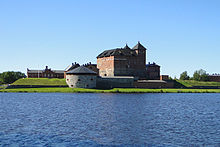
In 2017, tourism in Finland grossed approximately €15.0 billion. Of this, €4.6 billion (30%) came from foreign tourism.[202] In 2017, there were 15.2 million overnight stays of domestic tourists and 6.7 million overnight stays of foreign tourists.[203] Tourism contributes roughly 2.7% to Finland's GDP.[204]
Lapland has the highest tourism consumption of any Finnish region.[204] Above the Arctic Circle, in midwinter, there is a polar night, a period when the sun does not rise for days or weeks, or even months, and correspondingly, midnight sun in the summer, with no sunset even at midnight (for up to 73 consecutive days, at the northernmost point). Lapland is so far north that the aurora borealis, fluorescence in the high atmosphere due to solar wind, is seen regularly in the fall, winter, and spring. Finnish Lapland is also locally regarded as the home of Santa Claus, with several theme parks, such as Santa Claus Village and Santa Park in Rovaniemi.[13][205] Other significant tourist destinations in Lapland also include ski resorts (such as Levi, Ruka and Ylläs)[13][206] and sleigh rides led by either reindeer or huskies.[207][208]
Tourist attractions in Finland include the natural landscape found throughout the country as well as urban attractions. Finland contains 40 national parks (such as Koli National Park in North Karelia), from the Southern shores of the Gulf of Finland to the high fells of Lapland. Outdoor activities range from Nordic skiing, golf, fishing, yachting, lake cruises, hiking, and kayaking, among many others. Bird-watching is popular for those fond of avifauna, however, hunting is also popular.
The most famous tourist attractions in Helsinki include the Helsinki Cathedral and the Suomenlinna sea fortress.[13] The most well-known Finnish amusement parks include Linnanmäki in Helsinki and Särkänniemi in Tampere.[209] St. Olaf's Castle (Olavinlinna) in Savonlinna hosts the annual Savonlinna Opera Festival,[210] and the medieval milieus of the cities of Turku, Rauma and Porvoo also attract spectators.[13][211] Commercial cruises between major coastal and port cities in the Baltic region play a significant role in the local tourism industry.
Demographics
The population of Finland is about 5.6 million. The birth rate is 7.8 per 1,000 residents, for a fertility rate of 1.26 children born per woman,[213] one of the lowest in the world, significantly below the replacement rate of 2.1. In 1887 Finland recorded its highest rate, 5.17 children born per woman.[214] Finland has one of the oldest populations in the world, with a median age of 42.6 years.[215] Approximately half of voters are estimated to be over 50 years old.[216][89][217][218] Finland has an average population density of 18 inhabitants per square kilometre. This is the third-lowest population density of any European country, behind those of Norway and Iceland, and the lowest population density of any European Union member country. Finland's population has always been concentrated in the southern parts of the country, a phenomenon that became even more pronounced during 20th-century urbanization. Three of the four largest cities in Finland are situated in the Helsinki metropolitan area —Helsinki, Espoo and Vantaa.[219] In the largest cities of Finland, Tampere holds the third place after Helsinki and Espoo while also Helsinki-neighbouring Vantaa is the fourth. Other cities with population over 100,000 are Turku, Oulu, Jyväskylä, Kuopio, and Lahti.
Finland's immigrant population is growing.[220] As of 2023[update], there were 571,268 people with a foreign background living in Finland (10.2% of the population), most of whom are from the former Soviet Union, Estonia, Sweden, Iraq, China and India.[1] The children of foreigners are not automatically given Finnish citizenship, as Finnish nationality law practices and maintain jus sanguinis policy where only children born to at least one Finnish parent are granted citizenship. If they are born in Finland and cannot get citizenship of any other country, they become citizens.[221] Additionally, certain persons of Finnish descent who reside in countries that were once part of Soviet Union, retain the right of return, a right to establish permanent residency in the country, which would eventually entitle them to qualify for citizenship.[222] As of 2023[update], 535,451 people in Finland were born in another country, representing 9,6 % of the population. The 10 largest foreign born groups are (in order) from Estonia, Sweden, Iraq, Russia, China, Ukraine, India, Somalia, Philippines, Thailand, Vietnam and Turkey.[223]
Finland's national minorities include the Sami, Romani people, the Jews and the Tatars. Romani people of the Finnish Kale group settled in the country at the end of the sixteenth century.[224]
Language
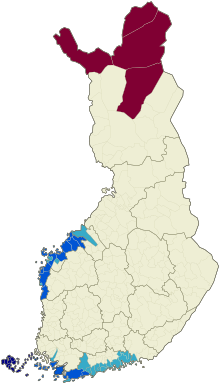
Finnish and Swedish are the official languages of Finland. Finnish predominates nationwide while Swedish is spoken in some coastal areas in the west and south (with towns such as Ekenäs,[225] Pargas,[226] Närpes,[226] Kristinestad,[227] Jakobstad[228] and Nykarleby.[229]) and in the autonomous region of Åland, which is the only monolingual Swedish-speaking region in Finland.[230] As of 2023[update], the native language of 84.9% of the population was Finnish,[1] which is part of the Finnic subgroup of the Uralic language. The language is one of only four official EU languages not of Indo-European origin, and has no relation through descent to the other national languages of the Nordics. Conversely, Finnish is closely related to Estonian and Karelian, and more distantly to Hungarian and the Sami languages.
Swedish is the native language of 5.1% of the population (Swedish-speaking Finns).[1] Swedish is a compulsory school subject and general knowledge of the language is good among many non-native speakers.[231] Likewise, a majority of Swedish-speaking non-Ålanders can speak Finnish.[232] The Finnish side of the land border with Sweden is unilingually Finnish-speaking. The Swedish across the border is distinct from the Swedish spoken in Finland. There is a sizeable pronunciation difference between the varieties of Swedish spoken in the two countries, although their mutual intelligibility is nearly universal.[233]
Finnish Romani is spoken by some 5,000–6,000 people; there are 13,000-14,000 Romani people in Finland[234] Romani and Finnish Sign Language are also recognized in the constitution. There are two sign languages: Finnish Sign Language, spoken natively by 4,000–5,000 people,[235] and Finland-Swedish Sign Language, spoken natively by about 150 people. Tatar is spoken by a Finnish Tatar minority of about 800 people whose ancestors moved to Finland mainly between the 1870s and 1920s.[236]
The Sámi languages have an official status in parts of Lapland, where the Sámi, numbering over 10,000[237] are recognized as an indigenous people. About a quarter of them speak a Sami language as their mother tongue.[238] The Sami languages that are spoken in Finland are Northern Sami, Inari Sami, and Skolt Sami.[note 4] The rights of minority groups (in particular Sami, Swedish speakers, and Romani people) are protected by the constitution.[239] The Nordic languages and Karelian are also specially recognized in parts of Finland.
As of 2023[update], the most common foreign languages are Russian (1.8%), Estonian (0.9%), Arabic (0.7%), English (0.6%) and Ukrainian (0.5%).[1]
English is studied by most pupils as a compulsory subject from the first grade (at seven years of age), formerly from the third or fifth grade, in the comprehensive school (in some schools other languages can be chosen instead).[240][241][242][243] German, French, Spanish and Russian can be studied as second foreign languages from the fourth grade (at 10 years of age; some schools may offer other options).[244]
Largest cities
Largest cities or towns in Finland
"Population increased most in Uusimaa in 2023". Statistics Finland. 31 December 2023. | |||||||||
|---|---|---|---|---|---|---|---|---|---|
| Rank | Name | Region | Pop. | Rank | Name | Region | Pop. | ||
| 1 | Helsinki | Uusimaa | 684,589 | 11 | Kouvola | Kymenlaakso | 78,399 | ||
| 2 | Espoo | Uusimaa | 321,031 | 12 | Joensuu | North Karelia | 78,743 | ||
| 3 | Tampere | Pirkanmaa | 260,358 | 13 | Lappeenranta | South Karelia | 73,369 | ||
| 4 | Vantaa | Uusimaa | 251,405 | 14 | Vaasa | Ostrobothnia | 70,374 | ||
| 5 | Oulu | North Ostrobothnia | 216,194 | 15 | Hämeenlinna | Kanta-Häme | 68,376 | ||
| 6 | Turku | Southwest Finland | 206,035 | 16 | Seinäjoki | South Ostrobothnia | 66,610 | ||
| 7 | Jyväskylä | Central Finland | 149,269 | 17 | Rovaniemi | Lapland | 65,738 | ||
| 8 | Kuopio | North Savo | 125,668 | 18 | Mikkeli | South Savo | 51,893 | ||
| 9 | Lahti | Päijät-Häme | 121,383 | 19 | Porvoo | Uusimaa | 51,753 | ||
| 10 | Pori | Satakunta | 83,316 | 20 | Salo | Southwest Finland | 50,867 | ||
Religion
Registered members of religions groups in Finland by the Statistics Finland (2023)[1]
With 3.5 million members,[245] the Evangelical Lutheran Church of Finland is Finland's largest religious body; at the end of 2023, 63.6% of Finns were members of the church.[1] The Evangelical Lutheran Church of Finland has seen its share of the country's population declining by roughly one percent annually in recent years. The decline has been due to both church membership resignations and falling baptism rates.[246][247] The second largest group, accounting for 26.3% of the population[248] in 2017, has no religious affiliation. A small minority belongs to the Finnish Orthodox Church (1.1%). Other Protestant denominations and the Roman Catholic Church are significantly smaller, as are the Jewish and other non-Christian communities (totalling 1.6%). The Pew Research Center estimated the Muslim population at 2.7% in 2016.[249]
Finland's state church was the Church of Sweden until 1809. As an autonomous Grand Duchy under Russia from 1809 to 1917, Finland retained the Lutheran State Church system, and the Evangelical Lutheran Church of Finland was established. After Finland had gained independence in 1917, religious freedom was declared in the constitution of 1919, and a separate law on religious freedom in 1922. Through this arrangement, the Evangelical Lutheran Church of Finland gained a constitutional status as a national church alongside the Finnish Orthodox Church, whose position however is not codified in the constitution. The main Lutheran and Orthodox churches have special roles such as in state ceremonies and schools.[250]
In 2016, 69.3% of Finnish children were baptized[251] and 82.3% were confirmed in 2012 at the age of 15,[252] and over 90% of the funerals are Christian. However, the majority of Lutherans attend church only for special occasions like Christmas ceremonies, weddings, and funerals. The Lutheran Church estimates that approximately 1.8% of its members attend church services weekly.[253] The average number of church visits per year by church members is approximately two.[254]
According to a 2010 Eurobarometer poll, 33% of Finnish citizens responded that they "believe there is a God"; 42% answered that they "believe there is some sort of spirit or life force"; and 22% that they "do not believe there is any sort of spirit, God, or life force".[255] According to ISSP survey data (2008), 8% consider themselves "highly religious", and 31% "moderately religious". In the same survey, 28% reported themselves as "agnostic" and 29% as "non-religious".[256]
Health
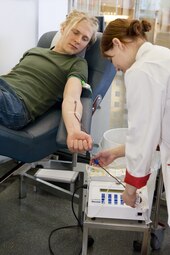
Life expectancy was 79 years for men and 84 years for women in 2017.[257] The under-five mortality rate was 2.3 per 1,000 live births in 2017, ranking Finland's rate among the lowest in the world.[258] The fertility rate in 2014 stood at 1.71 children born/per woman and has been below the replacement rate of 2.1 since 1969.[259] With a low birth rate women also become mothers at a later age, the mean age at first live birth being 28.6 in 2014.[259] A 2011 study published in The Lancet medical journal found that Finland had the lowest stillbirth rate out of 193 countries.[260]
There has been a slight increase or no change in welfare and health inequalities between population groups in the 21st century. Lifestyle-related diseases are on the rise. More than half a million Finns suffer from diabetes, type 1 diabetes being globally the most common in Finland. Many children are diagnosed with type 2 diabetes. The number of musculoskeletal diseases and cancers are increasing, although the cancer prognosis has improved. Allergies and dementia are also growing health problems in Finland. One of the most common reasons for work disability are due to mental disorders, in particular depression.[261] Without age standardization, the suicide rates were 13 per 100 000 in 2015, close to the North European average.[262] Age-standardized suicide rates are still among the highest among developed countries in the OECD.[263]
There are 307 residents for each doctor.[264] About 19% of health care is funded directly by households and 77% by taxation.
In April 2012, Finland was ranked second in Gross National Happiness in a report published by The Earth Institute.[265] Since 2012, Finland has every time ranked at least in the top 5 of world's happiest countries in the annual World Happiness Report by the United Nations,[266][267][268] as well as ranking as the happiest country since 2018.[269][270]
Education and science
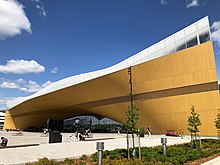
Most pre-tertiary education is arranged at the municipal level. Around 3 percent of students are enrolled in private schools (mostly specialist language and international schools).[272] Formal education is usually started at the age of 7. Primary school takes normally six years and lower secondary school three years.
The curriculum is set by the Ministry of Education and Culture and the Education Board. Education is compulsory between the ages of 7 and 18. After lower secondary school, graduates may apply to trade schools or gymnasiums (upper secondary schools). Trade schools offer a vocational education: approximately 40% of an age group choose this path after the lower secondary school.[273] Academically oriented gymnasiums have higher entrance requirements and specifically prepare for Abitur and tertiary education. Graduation from either formally qualifies for tertiary education.

In tertiary education, two mostly separate and non-interoperating sectors are found: the profession-oriented polytechnics and the research-oriented universities. Education is free and living expenses are to a large extent financed by the government through student benefits. There are 15 universities and 24 Universities of Applied Sciences (UAS) in the country.[274][275] The University of Helsinki is ranked 75th in the Top University Ranking of 2010.[276] Other reputable universities of Finland include Aalto University in Espoo, both University of Turku and Åbo Akademi University in Turku, University of Jyväskylä, University of Oulu, LUT University in Lappeenranta and Lahti, University of Eastern Finland in Kuopio and Joensuu, and Tampere University.[277]
The World Economic Forum ranks Finland's tertiary education No. 1 in the world.[278] Around 33% of residents have a tertiary degree, similar to Nordics and more than in most other OECD countries except Canada (44%), United States (38%) and Japan (37%).[279] In addition, 38% of Finland's population has a university or college degree, which is among the highest percentages in the world.[280][281] Adult education appears in several forms, such as secondary evening schools, civic and workers' institutes, study centres, vocational course centres, and folk high schools.[153]
More than 30% of tertiary graduates are in science-related fields. Forest improvement, materials research, environmental sciences, neural networks, low-temperature physics, brain research, biotechnology, genetic technology, and communications showcase fields of study where Finnish researchers have had a significant impact.[282] Finland is highly productive in scientific research. In 2005, Finland had the fourth most scientific publications per capita of the OECD countries.[283] In 2007, 1,801 patents were filed in Finland.[284]
Culture
Literature
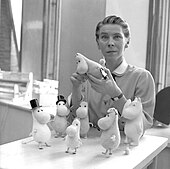
Written Finnish could be said to have existed since Mikael Agricola translated the New Testament into Finnish during the Protestant Reformation, but few notable works of literature were written until the 19th century and the beginning of a Finnish national Romantic Movement. This prompted Elias Lönnrot to collect Finnish and Karelian folk poetry and arrange and publish them as the Kalevala, the Finnish national epic. The era saw a rise of poets and novelists who wrote in Finnish, notably the national writer of Finland, Aleksis Kivi (The Seven Brothers), and Minna Canth, Eino Leino, and Juhani Aho. Many writers of the national awakening wrote in Swedish, such as the national poet J. L. Runeberg (The Tales of Ensign Stål) and Zachris Topelius.
After Finland became independent, there was a rise of modernist writers, most famously the Swedish-speaking poet Edith Södergran. Finnish-speaking authors explored national and historical themes. Most famous of them were Frans Eemil Sillanpää, who was awarded the Nobel Prize in Literature in 1939, historical novelist Mika Waltari, and Väinö Linna with his The Unknown Soldier and Under the North Star trilogy. Beginning with Paavo Haavikko, Finnish poetry adopted modernism. Besides Lönnrot's Kalevala and Waltari, the Swedish-speaking Tove Jansson, best known as the creator of The Moomins, is the most translated Finnish writer;[285] her books have been translated into more than 40 languages.[286]
Visual arts, design, and architecture
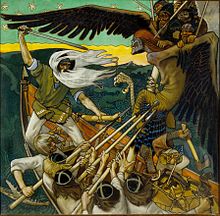
The visual arts in Finland started to form their characteristics in the 19th century when Romantic nationalism was rising in autonomic Finland. The best known Finnish painters, Akseli Gallen-Kallela, started painting in a naturalist style but moved to national romanticism. Other notable painters of the era include Pekka Halonen, Eero Järnefelt, Helene Schjerfbeck and Hugo Simberg. In the late 20th century, the homoerotic art of Touko Laaksonen, pseudonym Tom of Finland, found a worldwide audience.[287][288]
Finland's best-known sculptor of the 20th century was Wäinö Aaltonen, remembered for his monumental busts and sculptures. The works of Eila Hiltunen and Laila Pullinen exemplifies the modernism in sculpture.
Finns have made major contributions to handicrafts and industrial design: among the internationally renowned figures are Timo Sarpaneva, Tapio Wirkkala and Ilmari Tapiovaara. Finnish architecture is famous around the world, and has contributed significantly to several styles internationally, such as Jugendstil (or Art Nouveau), Nordic Classicism and functionalism. Among the top 20th-century Finnish architects to gain international recognition are Eliel Saarinen and his son Eero Saarinen. Architect Alvar Aalto is regarded as among the most important 20th-century designers in the world;[289] he helped bring functionalist architecture to Finland, but soon was a pioneer in its development towards an organic style.[290] Aalto is also famous for his work in furniture, lamps, textiles, and glassware, which were usually incorporated into his buildings.
Music
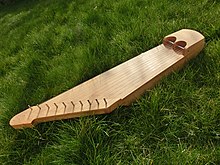
- Folk
Finnish folk music can be divided into Nordic dance music and the older tradition of poem singing, poems from which the national epic, the Kalevala, was created. Much of Finland's classical music is influenced by traditional Finnish and Karelian melodies and lyrics, as comprised in the Kalevala. In the historical region of Finnish Karelia, as well as other parts of Eastern Finland, the old poem singing traditions were preserved better than in the western parts of the country. In the 19th century Nordic folk dance music largely replaced the kalevaic tradition. Finnish folk music has undergone a roots revival and has become a part of popular music. The people of northern Finland, Sweden, and Norway, the Sami, are known primarily for highly spiritual songs called joik.
- Classical
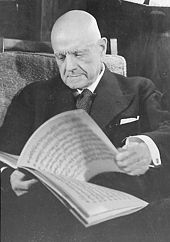
The first Finnish opera was written by the German-born composer Fredrik Pacius in 1852. Pacius also wrote the music to the poem Maamme/Vårt land (Our Country), Finland's national anthem. In the 1890s Finnish nationalism based on the Kalevala spread, and Jean Sibelius became famous for his vocal symphony Kullervo. In 1899 he composed Finlandia, which played an important role in Finland gaining independence. He remains one of Finland's most popular national figures.
Alongside Sibelius, the distinct Finnish style of music was created by Oskar Merikanto, Toivo Kuula, Erkki Melartin, Leevi Madetoja and Uuno Klami. Important modernist composers include Einojuhani Rautavaara, Aulis Sallinen and Magnus Lindberg, among others. Kaija Saariaho was ranked the world's greatest living composer in a 2019 composers' poll.[291] Many Finnish musicians have achieved international success. Among them are the conductor Esa-Pekka Salonen, the opera singer Karita Mattila and the violinist Pekka Kuusisto.
- Popular music

Iskelmä (coined directly from the German word Schlager, meaning "hit") is a traditional Finnish word for a light popular song.Finnish popular music also includes various kinds of dance music; tango, a style of Argentine music, is also popular.[292] The light music in Swedish-speaking areas has more influences from Sweden. At least a couple of Finnish polkas are known worldwide, such as Säkkijärven polkka[293] and "Ievan polkka".[294]
During the 1970s, progressive rock group Wigwam and rock and roll group Hurriganes gained respect abroad. The Finnish punk scene produced some internationally acknowledged names including Terveet Kädet in the 1980s. Hanoi Rocks was a pioneering glam rock act.[295] Many Finnish metal bands have gained international recognition; Finland has been often called the "Promised Land of Heavy Metal" because there are more than 50 metal Bands for every 100,000 inhabitants – more than any other nation in the world.[296][297] Modern Finnish popular music includes a number of prominent rock musicians, pop musicians, jazz musicians, hip hop performers, and dance music acts.[298][299][300][301]
Finland has won the Eurovision Song Contest once in 2006 when Lordi won the contest with the song ''Hard Rock Hallelujah''.[302] The Finnish pop artist Käärijä also got second place in the contest in 2023 with his worldwide hit song ''Cha Cha Cha''.[303][304]
Cinema and television
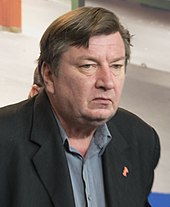
In the film industry, notable modern directors include brothers Mika and Aki Kaurismäki, Dome Karukoski, Antti Jokinen, Jalmari Helander, and Renny Harlin. Some Finnish drama series are internationally known, such as Bordertown.[305]
One of the most internationally successful Finnish films are The White Reindeer, directed by Erik Blomberg in 1952, which won the Golden Globe Award for Best Foreign Film in 1956;[306][307] The Man Without a Past, directed by Aki Kaurismäki in 2002, which was nominated for the Academy Award for Best Foreign Language Film in 2002 and won the Grand Prix at the 2002 Cannes Film Festival;[308] and The Fencer, directed by Klaus Härö in 2015, which was nominated for the 73rd Golden Globe Awards in the Best Foreign Language Film category as a Finnish/German/Estonian co-production.[309]
In Finland, the most significant films include The Unknown Soldier, directed by Edvin Laine in 1955.[310] Here, Beneath the North Star from 1968, is also one of the most significant works in Finnish history.[311] A 1960 crime comedy film Inspector Palmu's Mistake, directed by Matti Kassila, was voted in 2012 the best Finnish film of all time by Finnish film critics and journalists,[312] but the 1984 comedy film Uuno Turhapuro in the Army, the ninth film in Uuno Turhapuro film series, remains Finland's most seen domestic film made since 1968 by Finnish audience.[313]
Media and communications
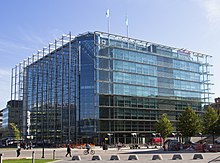
Today, there are around 200 newspapers, 320 popular magazines, 2,100 professional magazines, and 67 commercial radio stations. The largest newspaper is Helsingin Sanomat, its circulation being 339,437 as of 2019[update].[314] Yle, the Finnish Broadcasting Company, operates five television channels and thirteen radio channels. Each year, around 12,000 book titles are published.[315]
Thanks to its emphasis on transparency and equal rights, Finland's press has been rated the freest in the world.[316] Worldwide, Finns, along with other Nordic peoples and the Japanese, spend the most time reading newspapers.[317] In regards to telecommunication infrastructure, Finland is the highest ranked country in the World Economic Forum's Network Readiness Index (NRI) – an indicator for determining the development level of a country's information and communication technologies.[318]
Sauna

The Finns' love for saunas is generally associated with Finnish cultural tradition. Sauna is a type of dry steam bath practiced widely in Finland, which is especially evident in the strong tradition around Midsummer and Christmas. The word sauna is of Proto-Finnish origin (found in Finnic and Sami languages) dating back 7,000 years.[319] Steam baths have been part of European tradition elsewhere as well, but the sauna has survived best in Finland, in addition to Sweden, Estonia, Latvia, Russia, Norway, and parts of the United States and Canada. Moreover, nearly all Finnish houses have either their own sauna or in multi-story apartment houses, a timeshare sauna. Municipal swimming halls and hotels have often their own saunas. The Finnish sauna culture is inscribed on the UNESCO Intangible Cultural Heritage Lists.[320][321]
Cuisine
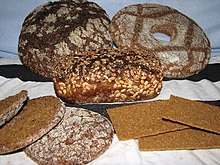
Finnish cuisine generally combines traditional country fare and contemporary style cooking. Potato, meat and fish play a prominent role in traditional Finnish dishes. Finnish foods often use wholemeal products (rye, barley, oats) and berries (such as bilberries, lingonberries, cloudberries, and sea buckthorn). Milk and its derivatives like buttermilk are commonly used as food and drink. The most popular fish food in Finland is salmon.[323][324]
Finland has the world's second highest per capita consumption of coffee.[325] Milk consumption is also high, at an average of about 112 litres (25 imp gal; 30 US gal), per person, per year,[326] even though 17% of the Finns are lactose intolerant.[327]
Public holidays
There are several holidays in Finland, of which perhaps the most characteristic of Finnish culture include Christmas (joulu), Midsummer (juhannus), May Day (vappu) and Independence Day (itsenäisyyspäivä). Of these, Christmas and Midsummer are special in Finland because the actual festivities take place on eves, such as Christmas Eve[328][329] and Midsummer's Eve,[330][331] while Christmas Day and Midsummer's Day are more consecrated to rest. Other public holidays in Finland are New Year's Day, Epiphany, Good Friday, Easter Sunday and Easter Monday, Ascension Day, All Saints' Day and Saint Stephen's Day. All official holidays in Finland are established by Acts of Parliament.[332]
Sports

Various sporting events are popular in Finland. Pesäpallo, the Finnish equivalent of American baseball, is the national sport of Finland,[335][336] although the most popular sport in terms of spectators is ice hockey.[337] Other popular sports include athletics, cross-country skiing, ski jumping, football, volleyball, and basketball.[338] Association football is the most played team sport in terms of the number of players in the country.[339][340] Finland's national basketball team has received widespread public attention.[341]
In terms of medals and gold medals won per capita, Finland is the best-performing country in Olympic history.[342] Finland first participated as a nation in its own right at the Olympic Games in 1908. At the 1912 Summer Olympics, three gold medals were won by the original "Flying Finn" Hannes Kolehmainen. In the 1920s and '30s, Finnish long-distance runners dominated the Olympics, with Paavo Nurmi winning a total of nine Olympic gold medals and setting 22 official world records between 1921 and 1931. Nurmi is often considered the greatest Finnish sportsman and one of the greatest athletes of all time. The 1952 Summer Olympics were held in Helsinki.
The javelin throw event has brought Finland nine Olympic gold medals, five world championships, five European championships, and 24 world records. Finland also has a notable history in figure skating. Finnish skaters have won 8 world championships and 13 junior world cups in synchronized skating.
Finnish competitors have achieved significant success in motorsport. In the World Rally Championship, Finland has produced eight world champions, more than any other country.[343] In Formula One, Finland has won the most world championships per capita, with Keke Rosberg, Mika Häkkinen and Kimi Räikkönen all having won the title.[344]
Some of the most popular recreational sports and activities include Nordic walking, running, cycling and skiing. Floorball is the most popular youth and workplace sport.[345]
See also
Notes
- ^ Includes Finland-Swedes, Romani, Tatar and Sámi people.
- ^ Finland was the first nation in the world to give all (adult) citizens full suffrage, in other words the right to vote and to run for office, in 1906. New Zealand was the first country in the world to grant all (adult) citizens the right to vote in 1893, but women did not get the right to run for the New Zealand legislature until 1919.
- ^ The role that the regional councils serve on Mainland Finland are on Åland handled by the autonomous Government of Åland.
- ^ The names for Finland in its Sami languages are: Suopma (Northern Sami), Suomâ (Inari Sami) and Lää'ddjânnam (Skolt Sami). See Geonames.de.
- ^ Finnish: Suomi [ˈsuo̯mi] ⓘ; Swedish: Finland Swedish pronunciation: [ˈfinlɑnd]
- ^ Finnish: Suomen tasavalta; Swedish: Republiken Finland; ⓘ
- ^ "Republic of Finland", or Suomen tasavalta in Finnish, Republiken Finland in Swedish, and Suoma dásseváldi in Sami, is the long protocol name, which is however not defined by law. Legislation recognizes only the short name.
References
- ^ a b c d e f g h i j k "Population growth biggest in nearly 70 years". Population structure. Statistics Finland. 26 April 2024. ISSN 1797-5395. Archived from the original on 28 April 2024. Retrieved 29 April 2024.
- ^ a b Nousiainen, Jaakko (June 2001). "From semi-presidentialism to parliamentary government: political and constitutional developments in Finland". Scandinavian Political Studies. 24 (2): 95–109. doi:10.1111/1467-9477.00048. ISSN 0080-6757.
- ^ The Soviet Russia's recognition of Finland's independence Dec. 1917 - Jan. 1918, archived from the original on 22 February 2024, retrieved 22 February 2024
- ^ a b "Finland". Central Intelligence Agency. 8 August 2023. Archived from the original on 20 December 2022. Retrieved 23 January 2021 – via CIA.gov.
- ^ "Surface water and surface water change". Organisation for Economic Co-operation and Development (OECD). Archived from the original on 24 March 2021. Retrieved 11 October 2020.
- ^ a b c d "World Economic Outlook Database, October 2024 Edition. (Finland)". www.imf.org. International Monetary Fund. 22 October 2024. Retrieved 29 November 2024.
- ^ "Gini coefficient of equivalised disposable income". Eurostat. Archived from the original on 9 October 2020. Retrieved 14 March 2024.
- ^ "Human Development Report 2023/24" (PDF). United Nations Development Programme. 13 March 2024. p. 279. Archived (PDF) from the original on 13 March 2024. Retrieved 14 March 2024.
- ^ Ajanilmaukset Archived 20 October 2017 at the Wayback Machine Kielikello 2/2006. Institute for the Languages of Finland. Retrieved 20 October 2017
- ^ "Finland Population 2024 (Live)". worldpopulationreview.com. Retrieved 9 August 2024.
- ^ "Språk i Finland" [Language in Finland]. Institute for the Languages of Finland (in Swedish). Archived from the original on 4 January 2023. Retrieved 8 December 2021.
- ^ a b Li, Leslie (16 April 1989). "A Land of a Thousand Lakes". The New York Times. Archived from the original on 2 January 2010. Retrieved 20 September 2020.
- ^ a b c d e f Mansel, Lydia (15 November 2023). "15 Best Places to Visit in Finland, From the Sauna Capital of the World to Santa Claus Village". Travel + Leisure. Archived from the original on 2 January 2024. Retrieved 2 January 2024.
- ^ Haggren, Georg; Halinen, Petri; Lavento, Mika; Raninen, Sami; Wessman, Anna (2015). Muinaisuutemme jäljet. Helsinki: Gaudeamus. p. 23. ISBN 978-952-495-363-4.
- ^ Haggren, Georg; Halinen, Petri; Lavento, Mika; Raninen, Sami; Wessman, Anna (2015). Muinaisuutemme jäljet. Helsinki: Gaudeamus. p. 339. ISBN 978-952-495-363-4.
- ^ Parliament of Finland. "History of the Finnish Parliament". eduskunta.fi. Archived from the original on 6 December 2015.
- ^ "Finland". International Monetary Fund. Archived from the original on 14 October 2017. Retrieved 17 April 2013.
- ^ "Finland: World Audit Democracy Profile". WorldAudit.org. Archived from the original on 30 October 2013.
- ^ "Tertiary education graduation rates—Education: Key Tables from OECD". OECD iLibrary. Organisation for Economic Co-operation and Development. 14 June 2010. doi:10.1787/20755120-table1 (inactive 2 November 2024). Archived from the original on 30 April 2011. Retrieved 6 March 2011.
{{cite web}}: CS1 maint: DOI inactive as of November 2024 (link) - ^ "Her er verdens mest konkurransedyktige land—Makro og politikk". E24.no. 9 September 2010. Archived from the original on 14 October 2010. Retrieved 6 March 2011.
- ^ "The 2009 Legatum Prosperity Index". Prosperity.com. Archived from the original on 29 October 2009. Retrieved 4 February 2010.
- ^ Haggrén et al. 2015, p. 109.
- ^ "eläinpääase; karhunpäänuija". Museovirasto (in Finnish). Archived from the original on 1 December 2017. Retrieved 30 November 2017.
- ^ Herkules.oulu.fi Archived 3 March 2016 at the Wayback Machine. People, material, culture and environment in the north. Proceedings of the 22nd Nordic Archaeological Conference, University of Oulu, 18–23 August 2004 Edited by Vesa-Pekka Herva.
- ^ Pirjo Uino of the National Board of Antiquities, ThisisFinland—"Prehistory: The ice recedes—man arrives". Retrieved 24 June 2008.
- ^ History of Finland and the Finnish People from stone age to WWII. Retrieved 24 June 2008.
- ^ a b Kirby 2006, p. 2.
- ^ Professor Frank Horn of the Northern Institute for Environmental and the Minority Law University of Lappland writing for Virtual Finland on National Minorities of Finland. Retrieved 24 June 2008.
- ^ a b Haggren, Georg; Halinen, Petri; Lavento, Mika; Raninen, Sami; Wessman, Anna (2015). Muinaisuutemme jäljet. Helsinki: Gaudeamus. pp. 199, 210–211.
- ^ Haggren, Georg; Halinen, Petri; Lavento, Mika; Raninen, Sami; Wessman, Anna (2015). Muinaisuutemme jäljet. Helsinki: Gaudeamus. pp. 171–178.
- ^ Haggren, Georg; Halinen, Petri; Lavento, Mika; Raninen, Sami; Wessman, Anna (2015). Muinaisuutemme jäljet. Helsinki: Gaudeamus. pp. 189–190.
- ^ Haggren, Georg; Halinen, Petri; Lavento, Mika; Raninen, Sami; Wessman, Anna (2015). Muinaisuutemme jäljet. Helsinki: Gaudeamus. pp. 332, 364–365.
- ^ Haggren, Georg; Halinen, Petri; Lavento, Mika; Raninen, Sami; Wessman, Anna (2015). Muinaisuutemme jäljet. Helsinki: Gaudeamus. p. 269.
- ^ Haggren, Georg; Halinen, Petri; Lavento, Mika; Raninen, Sami; Wessman, Anna (2015). Muinaisuutemme jäljet. Helsinki: Gaudeamus. pp. 211–212.
- ^ Rossi, Venla: "7 väärinkäsitystä suomen kielestä". Helsingin Sanomat. 11 September 2022. (in Finnish).
- ^ de Smit, Merlijn. "De Vanitate Etymologiae. On the origins of Suomi, Häme, Sápmi". Academia.edu. Academia, Inc. Retrieved 6 September 2020.
- ^ Salo, Unto (2004). Suomen museo 2003: "The Origins of Finland and Häme". Helsinki: Suomen muinaismuistoyhdistys. p. 55. ISBN 978-951-9057-55-2.
- ^ Kurt Villads Jensen (2019). Ristiretket. Turun Historiallinen Yhdistys. pp. 126–127.
- ^ Haggren, Georg; Halinen, Petri; Lavento, Mika; Raninen, Sami; Wessman, Anna (2015). Muinaisuutemme jäljet. Helsinki: Gaudeamus. p. 380.
- ^ Tarkiainen, Kari (2010). Ruotsin itämaa. Helsinki: Svenska litteratursällskapet i Finland. p. 88.
- ^ Tarkiainen, Kari (2010). Ruotsin itämaa. Helsinki: Svenska litteratursällskapet i Finland. pp. 104–147. ISBN 978-951-583-212-2.
- ^ Tarkiainen, Kari (2010). Ruotsin itämaa. Porvoo: Svenska litteratursällskapet i Finland. pp. 167–170. ISBN 978-951-583-212-2.
- ^ a b "Finnish history". infoFinland.fi. Archived from the original on 13 April 2023. Retrieved 13 April 2023.
- ^ a b Kirby 2006, p. 9.
- ^ Sanders, Ruth H. (2021). The Languages of Scandinavia: Seven Sisters of the North. University of Chicago Press. pp. 94–95. ISBN 978-0-226-75975-3.
- ^ The Nordic Languages. W. de Gruyter. 2002. p. 1648. ISBN 978-3-11-017149-5.
- ^ Historical Dictionary of Finland. Rowman & Littlefield Publishers. 2021. p. 282. ISBN 978-1-5381-1154-3.
- ^ Kirby 2006, p. 28.
- ^ Kirby 2006, pp. 37–38.
- ^ Books from Finland. Publishers' Association of Finland. 1992. p. 180.
- ^ "Ruttopuisto – Plague Park". Tabblo.com. Archived from the original on 11 April 2008. Retrieved 3 November 2008.
- ^ "Archives of the Royal Academy of Turku and the Imperial Alexander University". Memory of the World Programme. UNESCO National Committee. Archived from the original on 26 March 2023. Retrieved 1 July 2022.
- ^ Jussi Välimaa (2019). "The Founding of the Royal Academy of Turku in 1640". A History of Finnish Higher Education from the Middle Ages to the 21st Century. Springer. pp. 77–78. ISBN 978-3030208073.
- ^ Kankaanpää, Matti J. (2016). Suomalainen ratsuväki Ruotsin ajalla (in Finnish). Porvoo: T:mi Toiset aijat. p. 790. ISBN 978-952-99106-9-4.
- ^ a b "Finland and the Swedish Empire Archived 26 December 2016 at the Wayback Machine". Federal Research Division, Library of Congress.
- ^ a b c "Tracing Finland's eastern border". thisisFINLAND. 22 March 2011. Archived from the original on 12 July 2020. Retrieved 14 July 2021.
- ^ Merivirta, Raita; Koivunen, Leila; Särkkä, Timo (1 January 2022). Finnish Colonial Encounters: From Anti-Imperialism to Cultural Colonialism and Complicity. Springer Nature. p. 43. ISBN 978-3-030-80610-1.
- ^ a b Junnila, Olavi (1986). "Autonomian rakentaminen ja kansallisen nousun aika". Suomen historia 5 (in Finnish). Helsinki: Weilin + Göös. p. 151. ISBN 951-35-2494-9.
- ^ "Pankinjohtaja Sinikka Salon puhe Snellman ja Suomen markka -näyttelyn avajaisissa Suomen Pankin rahamuseossa" (in Finnish). Bank of Finland. 10 January 2006. Archived from the original on 9 December 2017. Retrieved 7 December 2020.
- ^ Lefaivre, Liane; Tzonis, Alexander (2020). Architecture of Regionalism in the Age of Globalization: Peaks and Valleys in the Flat World. New York: Routledge. p. 144. ISBN 978-1-00-022106-0.
- ^ Nordstrom, Byron J. (2000). Scandinavia Since 1500. Minneapolis, US: University of Minnesota Press. p. 143. ISBN 978-0-8166-2098-2.
- ^ Gershwin, M. Eric; German, J. Bruce; Keen, Carl L. (2000). Nutrition and immunology: principles and practice. Humana Press. ISBN 0-89603-719-3.
- ^ a b c "Growth and Equity in Finland" (PDF). World Bank. Archived (PDF) from the original on 13 November 2018. Retrieved 22 March 2008.
- ^ Mickelsson, Rauli (2007). Suomen puolueet—Historia, muutos ja nykypäivä. Vastapaino. (in Finnish)
- ^ Alenius, Kari. "Russification in Estonia and Finland Before 1917", Faravid, 2004, Vol. 28, pp. 181–194.
- ^ The Finnish Civil War, Federal Research Division of the Library of Congress Archived 28 December 2016 at the Wayback Machine. Countrystudies.us. Retrieved 18 May 2016.
- ^ "Uudenvuodenaatto Pietarin Smolnassa – Itsenäisyyden tunnustus 31.12.1917" (in Finnish). Ulkoministeriö. Archived from the original on 26 November 2016. Retrieved 14 September 2020.
- ^ Tuomas Tepora & Aapo Roselius (2014). "The War of Liberation, the Civil Guards, and the Veterans' Union: Public Memory in the Interwar Period". The Finnish Civil War 1918. History of Warfare (vol. 101). ISBN 978-90-04-24366-8.
- ^ Simbeteanu, Iulian. "«Reds» vs. «Whites»: The Finnish Civil War (January- May 1918)". Europe Centenary. Archived from the original on 1 July 2022. Retrieved 13 May 2024.
- ^ "A Country Study: Finland—The Finnish Civil War". Federal Research Division, Library of Congress. Archived from the original on 10 March 2012. Retrieved 11 December 2008.
- ^ "SDP:n puheenjohtaja halusi punadiktaattoriksi, mutta kuoli Stalinin vankileirillä" Archived 28 November 2021 at the Wayback Machine (in Finnish).
- ^ "Pääkirjoitus: Kansalaissota on arka muistettava" Archived 26 May 2022 at the Wayback Machine (in Finnish).
- ^ "Punaisten ja valkoisten perintöä vaalitaan yhä – Suomalaiset lähettivät yli 400 muistoa vuoden 1918 sisällissodasta" Archived 21 May 2022 at the Wayback Machine (in Finnish).
- ^ Manninen, Ohto (1980). Suur-Suomen ääriviivat: Kysymys tulevaisuudesta ja turvallisuudesta Suomen Saksan-politiikassa 1941. Helsinki: Kirjayhtymä. ISBN 951-26-1735-8.
- ^ Nygård, Toivo (1978). Suur-Suomi vai lähiheimolaisten auttaminen: Aatteellinen heimotyö itsenäisessä Suomessa. Helsinki: Otava. ISBN 951-1-04963-1.
- ^ Singleton, Fred; Upton, Anthony F. (1998). A short history of Finland. Cambridge University Press. p. 113. ISBN 978-0-521-64701-4.
- ^ Mononen, Juha (2 February 2009). "War or Peace for Finland? Neoclassical Realist Case Study of Finnish Foreign Policy in the Context of the Anti-Bolshevik Intervention in Russia 1918–1920". University of Tampere. Archived from the original on 7 June 2015. Retrieved 25 August 2020.
- ^ "Real bridge-builder became Finland's first female government minister – thisisFINLAND". thisisFINLAND. 29 September 2017. Archived from the original on 1 April 2023. Retrieved 7 December 2020.
- ^ Myrskylä, Pekka (20 February 2007). "From slash-and-burn fields to post-industrial society—90 years of change in industrial structure". Statistics Finland. Finland 1917–2007. Archived from the original on 20 January 2012. Retrieved 26 August 2010.
- ^ Manninen (2008), pp. 37, 42, 43, 46, 49
- ^ The secret pact that ushered in World War II and changed Europe Archived 2 May 2024 at the Wayback Machine. Share America, U.S. Department of State. 19 August 2022.
- ^ Tanner, Väinö (1956). The Winter War: Finland Against Russia, 1939–1940, Volume 312. Palo Alto: Stanford University Press. p. 114.
- ^ History.com (2009): USSR expelled from the League of Nations Archived 14 March 2024 at the Wayback Machine. A&E Television Networks.
- ^ Trotter (2002), pp. 234–235
- ^ Michael Jones (2013). "Leningrad: State of Siege". Basic Books. p. 38. ISBN 0-7867-2177-4
- ^ Defensive victory led the way to peace Archived 2 May 2024 at the Wayback Machine Max Jakobson, Helsingin Sanomat, 3 September 2004.
- ^ Hidden help from across the Atlantic Archived 29 January 2007 at the Wayback Machine, Helsingin Sanomat.
- ^ a b c "Population development in independent Finland—greying Baby Boomers". Statistics Finland. 5 December 2007. Archived from the original on 13 May 2024. Retrieved 13 May 2024.
Finland 1917–2007
- ^ Ford, Hal (August 1972). ESAU -LVI – FINLANDIZATION IN ACTION: HELSINKI'S EXPERIENCE WITH MOSCOW (PDF). DIRECTORATE OF INTELLIGENCE. Archived from the original (PDF) on 1 December 2020. Retrieved 16 August 2020.
- ^ Uusitalo, Hannu (October 1996). "Economic Crisis and Social Policy in Finland in the 1990s" (PDF). Working Paper Series. SPRC Discussion Paper No. 70. ISSN 1037-2741. Archived from the original (PDF) on 9 August 2017. Retrieved 21 January 2019.
- ^ formin.finland.fi Archived 5 January 2016 at the Wayback Machine; Suurlähettiläs Jaakko Blomberg: Kylmän sodan päättyminen, Suomi ja Viro – Ulkoasiainministeriö: Ajankohtaista. Retrieved 18 May 2016.
- ^ "TARJA HALONEN – President of Finland (2000–2012)". Council of Women World Leaders. Archived from the original on 19 May 2022. Retrieved 29 April 2022.
- ^ Holmström, Bengt; Korkman, Sixten; Pohjola, Matti (21 February 2014). "The nature of Finland's economic crisis and the prerequisites for growth". VNK.fi. Archived from the original on 20 January 2022. Retrieved 29 April 2022.
- ^ Virén, Matti; Vanhala, Juuso (30 June 2015). "Shortage of new firms jams labour market recovery". Bank of Finland Bulletin. Archived from the original on 21 May 2022. Retrieved 29 April 2022.
- ^ "Poll suggests record-level support for Finnish President". Yle News. 7 September 2019. Archived from the original on 29 April 2022. Retrieved 29 April 2022.
- ^ "Five things to know about Finland's new 'selfie' president Alex Stubb". euronews. 12 February 2024.
- ^ "MTV Uutisten kysely: Nato-jäsenyyden kannatus on noussut 30 prosenttiin, vastustus laskenut selvästi – "Turvallisempaa olisi lännen kanssa"". mtvuutiset.fi (in Finnish). 26 January 2022. Archived from the original on 16 May 2022. Retrieved 1 September 2023.
- ^ "MTV:n kysely: Nato-jäsenyyttä kannattaa 68 prosenttia suomalaisista – Venäjän vastatoimet huolestuttavat". mtvuutiset.fi (in Finnish). 11 April 2022. Archived from the original on 26 April 2022. Retrieved 1 September 2023.
- ^ "Ukraine War: Finland to decide on Nato membership in weeks says PM Marin". BBC News. 13 April 2022. Archived from the original on 13 May 2022. Retrieved 29 April 2022.
- ^ Gramer, Robbie (22 April 2022). "'Thanks, Putin': Finnish and Swedish Lawmakers Aim for NATO Membership". Foreign Policy. Archived from the original on 29 April 2022. Retrieved 29 April 2022.
- ^ Askew, Joshua (29 April 2022). "NATO chief says Finland and Sweden could join 'quickly' as both warm to membership". Euronews. Archived from the original on 28 April 2022. Retrieved 29 April 2022.
- ^ "UK agrees mutual security deals with Finland and Sweden". BBC. 11 May 2022. Archived from the original on 31 May 2022. Retrieved 12 May 2022.
The UK has agreed mutual security pacts with Sweden and Finland, agreeing to come to their aid should either nation come under attack. UK Prime Minister Boris Johnson visited both countries to sign the deals, amid debate about them joining Nato.
- ^ "Finland's leaders call for NATO membership 'without delay'". AP NEWS. 12 May 2022. Archived from the original on 14 May 2022. Retrieved 12 May 2022.
- ^ "Finland's Parliament approves Nato application in historic vote". Yle News. 17 May 2022. Archived from the original on 17 May 2022. Retrieved 18 May 2022.
- ^ a b Finland and Nato Archived 25 July 2022 at the Wayback Machine. Finnish Government 3 April 2023. Retrieved 4 April 2023.
- ^ "Statistics Finland, Environment and Natural Resources". Archived from the original on 8 March 2017. Retrieved 4 April 2013.
- ^ Coast and Archipelago Archived 26 April 2024 at the Wayback Machine Visit Finland. Retrieved 26 April 2024.
- ^ "Trends in sea level variability". Finnish Institute of Marine Research. 24 August 2004. Archived from the original on 27 February 2007. Retrieved 22 January 2007.
- ^ "Finland". Encyclopædia Britannica. Encyclopædia Britannica Ultimate Reference Suite. Chicago: Encyclopædia Britannica, 2011.
- ^ "Euroopan metsäisin maa". Luke (in Finnish). 2013. Archived from the original on 14 August 2021. Retrieved 30 April 2016.
- ^ "Iconic Finnish nature symbols stand out". This is Finland. 25 August 2014. Archived from the original on 25 October 2017. Retrieved 24 December 2020.
- ^ Dinerstein, Eric; Olson, David; Joshi, Anup; et al. (2017). "An Ecoregion-Based Approach to Protecting Half the Terrestrial Realm". BioScience. 67 (6): 534–545. doi:10.1093/biosci/bix014. ISSN 0006-3568. PMC 5451287. PMID 28608869.
- ^ Grantham, H. S.; Duncan, A.; Evans, T. D.; et al. (2020). "Anthropogenic modification of forests means only 40% of remaining forests have high ecosystem integrity – Supplementary Material". Nature Communications. 11 (1): 5978. Bibcode:2020NatCo..11.5978G. doi:10.1038/s41467-020-19493-3. ISSN 2041-1723. PMC 7723057. PMID 33293507.
- ^ "Nutritional and genetic adaptation of galliform birds: implications for hand-rearing and restocking". Oulu University Library (2000). 17 May 2001. Archived from the original on 9 April 2009. Retrieved 23 May 2008.
- ^ "BirdLife Finland". BirdLife International (2004) Birds in Europe: population estimates, trends and conservation status. Cambridge, UK. (BirdLife Conservation Series No. 12). Archived from the original on 26 January 2007. Retrieved 22 January 2007.
- ^ "Saimaa Ringed Seal". Archived from the original on 25 December 2018. Retrieved 22 December 2018.
- ^ "Saimaa Ringed Seal". Nationalparks.fi. Archived from the original on 26 January 2021. Retrieved 5 March 2021.
- ^ "SOS: Save our seals". this is Finland (Ministry for Foreign Affairs of Finland). Archived from the original on 10 September 2015.
- ^ Corona, Hanna (30 August 2022). "Finland - Forests and Forestry". Boreal Forest. Archived from the original on 21 September 2022. Retrieved 21 September 2022.
- ^ a b c d "Finland's climate". Finnish Meteorological Institute. Archived from the original on 21 July 2010. Retrieved 3 December 2012.
- ^ "The climate in Finland (finnish)". Archived from the original on 3 January 2015. Retrieved 3 January 2015.
- ^ a b Havas, Paavo. "Pohjoiset alueet / yleiskuvaus" (in Finnish). Archived from the original on 13 May 2013. Retrieved 3 December 2012.
- ^ "Finland's Northern Conditions: Challenges and Opportunities for Agriculture" (PDF). Ministry of Agriculture and Forestry, Finland. pp. 1–4. Archived from the original (PDF) on 7 April 2012. Retrieved 3 December 2012.
- ^ "2024 Environmental Performance Index". Environmental Performance Index. Retrieved 11 October 2024.
- ^ "2024 Environmental Performance Index - Finland". Environmental Performance Index. Retrieved 15 October 2024.
- ^ "Tervetuloa aluehallintoviraston verkkosivuille!" (in Finnish). State Provincial Office. Archived from the original on 15 March 2012. Retrieved 9 June 2012.
- ^ "Suomen hallintorakenteeseen ja maakuntauudistukseen liittyviä termejä sekä maakuntien ja kuntien nimet fi-sv-en-(ru)" (PDF). vnk.fi. pp. 8–9. Archived (PDF) from the original on 11 June 2022. Retrieved 23 August 2019.
- ^ "Valtioneuvosto päätti Uudenmaan ja Itä-Uudenmaan maakuntien yhdistämisestä" (in Finnish). Ministry of Finance. 22 October 2009. Archived from the original on 7 August 2011. Retrieved 30 December 2010.
- ^ "Kaupunkien ja kuntien lukumäärät ja väestötiedot" (in Finnish). Suomen Kuntaliitto – Association of Finnish Municipalities. Archived from the original on 8 January 2020. Retrieved 7 March 2021.
- ^ "Wellbeing services counties will be responsible for organising health, social and rescue services on 1 January 2023". Ministry of Social Affairs and Health. Archived from the original on 7 September 2023. Retrieved 7 September 2023.
- ^ "Constitution of Finland, 1999 (rev. 2011)". Constitute Project. Archived from the original on 5 March 2022. Retrieved 5 March 2022.
- ^ "Finland's conservative party picks ministers for right-wing coalition government – The Seattle Times". www.seattletimes.com. 18 June 2023. Archived from the original on 18 June 2023. Retrieved 18 June 2023.
- ^ Policing corruption, International Perspectives.
- ^ "File:Intentional homicides, 2016 (police-recorded offences per 100 000 inhabitants).png". Archived from the original on 20 September 2018. Retrieved 10 December 2010.
- ^ Finnish constitution Archived 13 November 2013 at the Wayback Machine, Section 93.
- ^ "The Nobel Peace Prize 2008". The Nobel Foundation. Nobel Foundation. Archived from the original on 12 June 2018. Retrieved 10 May 2009.
- ^ "Finnish government approves indefinite entry restrictions for Russians". 6 July 2023. Archived from the original on 20 July 2023. Retrieved 21 July 2023.
- ^ "Finland strengthens trade relations in increasingly important US market". Finnish Government. 12 December 2022. Archived from the original on 19 December 2023. Retrieved 19 December 2023.
- ^ "2024 Global Peace Index" (PDF).
- ^ "Ennätysmäärä vapaaehtoisia naisia suoritti varusmiespalveluksen – kotiutuneita yli 1000 -". Puolustusvoimat (in Finnish). 30 December 2022. Archived from the original on 2 January 2023. Retrieved 3 January 2023.
- ^ "Finland to raise wartime strength to 280,000 troops". 17 February 2017. Archived from the original on 2 December 2022. Retrieved 9 October 2022.
- ^ "Suomella on järisyttävän suuri ja kadehdittu tykistö". Archived from the original on 8 November 2022. Retrieved 9 October 2022.
- ^ Chertok, Paula (11 April 2015). "Finland - Sparta of the North". Euromaidan Press. Archived from the original on 14 October 2022. Retrieved 9 October 2022.
- ^ Työvoimakustannukset puuttuvat puolustusmenoista Archived 12 September 2018 at the Wayback Machine, Statistics Finland (in Finnish): Eurostat ranking is sixth, but the third when conscription is accounted.
- ^ "JEF cooperation". Ministry of Defence. Archived from the original on 19 December 2023. Retrieved 19 December 2023.
- ^ "European Union battlegroups". Finnish Defence Forces. Archived from the original on 17 January 2023. Retrieved 27 May 2018.
- ^ Chamberlain, Nigel (19 May 2014). "Is Finland taking a step closer to NATO membership" (PDF). NATO Watch. Archived (PDF) from the original on 9 June 2022. Retrieved 27 May 2018.
- ^ Memorandum of Understanding (MOU) Between the Government of the Republic of Finland and Headquarters, Supreme Allied Commander Transformation As Well As Supreme Headquarters Allied Powers Europe Regarding the Provision of Host Nation Support for the Execution of NATO: Operations / Exercises / Similar Military Activity (PDF) (Report). NATO. n.d. Archived from the original (PDF) on 3 August 2016. Retrieved 29 June 2022 – via Parliament of Finland.
- ^ Finnish soldiers involved in 20-minute gunfight in Afghanistan |Yle Uutiset Archived 8 September 2016 at the Wayback Machine. yle.fi. Retrieved 18 May 2016.
- ^ Finland's participation in NATO-led crisis management operations. Ministry for Foreign Affairs of Finland
- ^ Staalesen, Atle (18 December 2023). "New defence agreement: Finland invites American troops to bases in Lapland". The Barents Observer. Archived from the original on 19 December 2023. Retrieved 19 December 2023.
- ^ a b c d Text from PD source: US Library of Congress: A Country Study: Finland Archived 14 February 2015 at the Wayback Machine, Library of Congress Call Number DL1012 .A74 1990.
- ^ "Perustuslaki: 2. luku Perusoikeudet, 6 § Yhdenvertaisuus 2 momentti" (in Finnish). Finlex. 1999. Archived from the original on 23 April 2012. Retrieved 27 August 2020.
- ^ "Scores of the Democracy Ranking 2012". Global Democracy Ranking. 2012. Archived from the original on 23 April 2018. Retrieved 27 September 2013.
- ^ "Freedom of the Press: Finland". Freedom House. 2013. Archived from the original on 4 September 2019. Retrieved 27 September 2013.
- ^ "Statistics of the Human Development Report". United Nations Development Programme. 2013. Archived from the original on 28 November 2013. Retrieved 27 September 2013.
- ^ "Annual Report 2013: Finland". Amnesty International. 2013. Archived from the original on 31 December 2013. Retrieved 27 September 2013.
- ^ "Country Reports on Human Rights Practices for 2012: Finland". U.S. State of Department Bureau of Democracy, Human Rights and Labor. 2012. Archived from the original on 21 May 2018. Retrieved 27 September 2013.
- ^ "Finland ranks 6th in European LGTBQ+ rights comparison". Helsinki Times. 11 May 2023. Archived from the original on 12 May 2023. Retrieved 12 May 2023.
- ^ "Finland in Figures—National Accounts". Statistics Finland. Archived from the original on 22 August 2019. Retrieved 26 April 2007.
- ^ "Finland in Figures—Manufacturing". Statistics Finland. Archived from the original on 21 April 2019. Retrieved 26 April 2007.
- ^ a b "Key economic indicators of Finland". statista.com. 28 November 2022. Archived from the original on 11 July 2023. Retrieved 11 July 2023.
- ^ World Intellectual Property Organization (2024). "Global Innovation Index 2024: Unlocking the Promise of Social Entrepreneurship". www.wipo.int. World Intellectual Property Organization. p. 18. doi:10.34667/tind.50062. ISBN 978-92-805-3681-2. Retrieved 6 October 2024.
- ^ "Supplying more than 100 valves to the largest gold mine in Europe". AVK International. Archived from the original on 11 December 2023. Retrieved 11 December 2023.
- ^ Chen, Jackson (27 October 2023). "Agnico operating permit restored for Kittila mine in Finland". Mining.com. Archived from the original on 11 December 2023. Retrieved 11 December 2023.
- ^ "Gold production". Our World in Data. Archived from the original on 29 November 2023. Retrieved 19 December 2024.
- ^ "Suomalaisten tulot Euroopan keskitasoa. Hyvinvointipalvelut eivät paranna sijoitusta". Tilastokeskus.fi. 9 June 2008. Archived from the original on 12 January 2012. Retrieved 26 August 2010.
- ^ "Small enterprises grow faster than the big ones". Helsinkitimes.fi. 11 April 2008. Archived from the original on 26 August 2013. Retrieved 26 August 2010.
- ^ a b The Nordic Model of Welfare: A Historical Reappraisal, by Niels Finn Christiansen
- ^ Mikkonen, Antti (17 May 2013). "Sata suurinta työnantajaa: Nokia jäi kakkoseksi". Talouselämä. Archived from the original on 5 August 2019. Retrieved 5 August 2019.
- ^ "Tilastokeskus: Työllisyysasteen trendiluku heinäkuussa 73,7 prosenttia". 23 August 2022. Archived from the original on 10 October 2022. Retrieved 10 October 2022.
- ^ "Finland in Figures". Statistics Finland. Archived from the original on 11 July 2023. Retrieved 12 July 2023.
- ^ "Housing in Finland". Statistics Finland. Archived from the original on 20 January 2023. Retrieved 22 December 2022.
- ^ "Finland in Figures 2023 – key figures about us". Statistics Finland. 1 June 2023. Archived from the original on 11 July 2023. Retrieved 12 July 2023.
- ^ "Finland: Globalization Insurance: Finland's Leap of Caution". Cooperatives Build a Better Maine. Cooperative Maine Business Alliance & Cooperative Development Institute. Archived from the original on 2 February 2019. Retrieved 1 February 2019.
- ^ a b "Joko nyt? Olkiluodon ydinvoimalan viimeinen testi maalissa – maanantaista odotetaan suurta päivää". MTVuutiset.fi (in Finnish). STT. 13 April 2023. Archived from the original on 18 April 2023. Retrieved 18 April 2023.
- ^ "Electricity price statistics - Statistics Explained". Eurostat. 13 April 2023. ISSN 2443-8219. Retrieved 18 April 2023.
- ^ a b c "Energia" (in Finnish). Tilastokeskus. 3 March 2023. Archived from the original on 18 April 2023. Retrieved 18 April 2023.
- ^ "Sähkön tuotanto ja kulutus" (in Finnish). Fingrid. 19 May 2017. Retrieved 18 April 2023.
- ^ "Share of energy from renewable sources". Eurostat. 5 April 2023. NRG_IND_REN. Archived from the original on 18 April 2023. Retrieved 18 April 2023.
- ^ Autio, Antti (4 April 2021). "'Suomi pärjää ilman Venäjän sähköä' – omavaraisuus saavutetaan kahdessa vuodessa, arvioi Fingrid". Ilta-Sanomat (in Finnish). STT, Antti. Archived from the original on 18 April 2023. Retrieved 18 April 2023.
- ^ International Energy Agency (12 May 2022). "Oil Stocks of IEA Countries". Paris: IEA. Archived from the original on 16 May 2022. Retrieved 17 May 2022.
- ^ "Journey deep into the Finnish caverns where nuclear waste will be buried for millennia". Wired. 24 April 2017. Archived from the original on 26 August 2019. Retrieved 26 August 2019.
- ^ "Top Gear: Finland's Busiest Roads Revealed". News Now Finland. 19 March 2018. Archived from the original on 27 January 2021. Retrieved 27 August 2020.
- ^ "Statistics: A total of 18.3 million passengers flew via Finavia's airports in 2023". Finavia. 15 January 2024. Retrieved 22 October 2024.
- ^ Transport and communications ministry—Rail. For the year 2009 update: Finnish Railway Statistics 2010.
- ^ Neil Kent: Helsinki: A Cultural History, p. 18. Interlink Books, 2014. ISBN 978-1566565448.
- ^ "Tulihevonen saapui ensi kerran Hämeenlinnaan 150 vuotta sitten" [The "fire horse" arrived first time in Hämeenlinna 150 years ago]. Yle Häme (in Finnish). Yle. 31 January 2012. Archived from the original on 21 May 2022. Retrieved 17 March 2022.
- ^ "The Busiest Crossing". Discover the Baltic. 24 April 2009. Archived from the original on 26 March 2010.
- ^ "Oasis of the Seas: Fast Facts" (PDF). OasisoftheSeas.com. 10 September 2009. Archived from the original (PDF) on 20 February 2012. Retrieved 24 October 2009.
- ^ "Freedom of the Seas Fact Sheet – Royal Caribbean Press Center". royalcaribbeanpresscenter.com. Archived from the original on 30 September 2020. Retrieved 16 June 2020.
- ^ "Europe :: Finland – The World Factbook – Central Intelligence Agency". cia.gov. Archived from the original on 20 December 2022. Retrieved 16 June 2020.
- ^ a b c d The Nordic Model Archived 5 September 2012 at the Wayback Machine by Torben M. Andersen, Bengt Holmström, Seppo Honkapohja, Sixten Korkman, Hans Tson Söderström, Juhana Vartiainen
- ^ a b c "Finland economy". The Heritage Foundation. Archived from the original on 29 June 2011. Retrieved 26 August 2010.
- ^ "World Competitiveness Yearbook 2007". Imd.ch. Archived from the original on 12 June 2007. Retrieved 26 August 2010.
- ^ "The Global Competitiveness Report 2007–2008". World Economic Forum. Archived from the original on 19 June 2008. Retrieved 8 October 2008.
- ^ "Corruption Perceptions Index 2012 – Results". Transparency.org. Archived from the original on 29 November 2013. Retrieved 12 December 2012.
- ^ "Ranking of economies – Doing Business – World Bank Group". doingbusiness.org. Archived from the original on 15 September 2008. Retrieved 17 April 2008.
- ^ "company". Visit Häme.
- ^ Matkailutilinpito: Matkailun talous- ja työllisyysvaikutukset 2016–2017 (PDF) (Report) (in Finnish). Business Finland, Visit Finland. 2019. Archived (PDF) from the original on 15 April 2020. Retrieved 2 April 2020.
- ^ Ministry of Economic Affairs and Employment. "Finnish tourism in numbers". Archived from the original on 16 April 2020. Retrieved 2 April 2020.
- ^ a b Tourism as Export Infographic 2019 (PDF) (Report). Business Finland, Visit Finland. 2019. Archived (PDF) from the original on 15 April 2020. Retrieved 2 April 2020.
- ^ "The Real Home of Santa Claus in Finland". Archived from the original on 30 November 2017. Retrieved 20 November 2017.
- ^ Wood, Jessica (17 August 2017). "The Top 12 Ski Resorts in Finland". Culture Trip.
- ^ "Santa Claus Reindeer rides & excursions in Rovaniemi Lapland Finland". Santa Claus Village Rovaniemi Finland. Archived from the original on 18 August 2021. Retrieved 5 March 2021.
- ^ "Discover the winter magic with Huskies and Reindeers". yllas.fi. 14 June 2023. Archived from the original on 26 January 2021. Retrieved 5 March 2021.
- ^ "Top 6 Theme Parks And Amusement Parks in Finland". Trip101. 30 December 2019. Archived from the original on 17 June 2021. Retrieved 5 March 2021.
- ^ "Home – Savonlinna Opera Festival". Archived from the original on 22 July 2020. Retrieved 25 July 2020.
- ^ "5 Finnish cities that deserve a tourist visit". Foreigner.fi. 23 June 2019. Archived from the original on 10 August 2020. Retrieved 25 July 2020.
- ^ "Concepts: Origin and background country". Statistics Finland. Retrieved 18 July 2024.
- ^ "Immigration record high in Finland in 2023". Statistics Finland. 25 January 2024. Archived from the original on 25 January 2024. Retrieved 25 January 2024.
- ^ Roser, Max (2014). "Total Fertility Rate around the world over the last centuries". Our World in Data, Gapminder Foundation. Archived from the original on 5 February 2019. Retrieved 7 May 2019.
- ^ "World Factbook EUROPE : FINLAND". The World Factbook. 12 July 2018. Archived from the original on 20 December 2022. Retrieved 23 January 2021.
- ^ Tilastokeskus – Population Archived 11 June 2020 at the Wayback Machine. Stat.fi. Retrieved 18 May 2016.
- ^ "Median Age (Years)". GlobalHealthFacts.org. Archived from the original on 3 April 2013. Retrieved 22 March 2013.
- ^ "Finland in Figures > Population". stat.fi. Statistics Finland. 4 June 2020. Archived from the original on 23 December 2020. Retrieved 12 August 2020.
- ^ Kirkkonummen Sanomat: Nurmijärvi – ilmiö voimistui heinäkuussa – Kirkkonummella väkiluvun kasvu 1,2 % Archived 30 September 2020 at the Wayback Machine (in Finnish).
- ^ "Helsingin seudun vieraskielinen väestö yli kaksinkertaistuu vuoteen 2035 mennessä". Helsingin kaupunki. 13 July 2023. Archived from the original on 27 May 2019. Retrieved 27 May 2019.
- ^ "Child born in Finland". Finnish Immigration Service. Archived from the original on 5 May 2021. Retrieved 25 April 2021.
- ^ "Finnish Directorate of Immigration". 10 November 2011. Archived from the original on 10 November 2011.
- ^ "Population growth biggest in nearly 70 years - Statistics Finland". stat.fi. 26 April 2024. Retrieved 15 June 2024.
- ^ "Finland - World Directory of Minorities & Indigenous Peoples". 2 November 2023. Archived from the original on 4 May 2023. Retrieved 4 January 2024.
- ^ Seelinger, Lani (16 June 2015). "The 10 Most Beautiful Towns in Finland". Culture Trip. Archived from the original on 23 April 2021. Retrieved 23 April 2021.
- ^ a b "Twice a minority: foreign immigration to Swedish-speaking communities in Finland". helsinkitimes.fi. 12 December 2020. Archived from the original on 9 May 2021. Retrieved 23 April 2021.
- ^ "Discovering Swedish-speaking municipalities: Kristinestad". helsinkitimes.fi. 8 November 2014. Archived from the original on 23 April 2021. Retrieved 23 April 2021.
- ^ "Discovering Swedish-speaking municipalities: Jakobstad". helsinkitimes.fi. 8 January 2015. Archived from the original on 23 April 2021. Retrieved 23 April 2021.
- ^ "Discovering Swedish-speaking municipalities: Nykarleby". helsinkitimes.fi. 4 December 2014. Archived from the original on 23 April 2021. Retrieved 23 April 2021.
- ^ "Swedish language courses for foreigners in Åland | Nordic cooperation". norden.org. Archived from the original on 26 July 2020. Retrieved 25 July 2020.
- ^ "Europeans and their languages, the situation in 2005" (PDF). European Commission. Archived (PDF) from the original on 14 April 2016. Retrieved 5 January 2021.
- ^ Piippo, Mikael (12 December 2018). "Finlandssvenska ungdomar talar sällan finska – särskilt på nätet är finskan ovanlig". Hufvudstadsbladet. Archived from the original on 8 March 2021. Retrieved 5 January 2021.
- ^ "Det svenska språket i Finland" (in Swedish). InfoFinland. Archived from the original on 6 January 2021. Retrieved 5 January 2021.
- ^ "Romanit ovat etninen vähemmistö | Näin se näkyy meillä". Romanit.fi (in Finnish). Archived from the original on 14 February 2024. Retrieved 9 February 2024.
- ^ "Forskningscentralen för de inhemska språken—Teckenspråken i Finland" (in Swedish). Archived from the original on 18 March 2015.
- ^ "National Minorities of Finland, The Tatars". Forum.hunturk.net. Archived from the original on 11 December 2011. Retrieved 6 December 2011.
- ^ "Saamelaisten määrä Sisä-Suomessa". bárbmu ry/rs (in Finnish). 30 July 2017. Archived from the original on 18 January 2022. Retrieved 9 February 2024.
- ^ "The population of Finland in 2006". Statistics Finland. 31 December 2006. Archived from the original on 13 September 2023. Retrieved 4 September 2007.
- ^ "The Constitution of Finland, 17 § and 121 §" (PDF). FINLEX Data Bank. Archived from the original (PDF) on 13 November 2013. Retrieved 4 September 2007.
- ^ Teivainen, Aleksi (13 April 2019). "Finland's first-graders to start learning foreign language in spring 2020". Helsinki Times. Retrieved 1 May 2019.
- ^ Yang, Junyi (Spring 2018). Teachers' Role in Developing Healthy Self-esteem in Young Learners: A study of English language teachers in Finland (PDF) (Master's Degree Program in Early Language Education for Intercultural Communication thesis). University of Eastern Finland. Archived (PDF) from the original on 23 May 2019. Retrieved 1 May 2019.
- ^ Öhberg, Tony. "Finland Places Among the Top Four English-Speaking Countries in the World". Archived from the original on 25 July 2020. Retrieved 25 July 2020.
- ^ "Finland ranks sixth in English skills, early instruction crucial". Yle Uutiset. 12 February 2018. Archived from the original on 25 July 2020. Retrieved 25 July 2020.
- ^ Nuolijärvi, Pirkko (Fall 2011). Language education policy and practice in Finland (PDF). European Federation of National Institutions for Language. Archived from the original (PDF) on 22 December 2022. Retrieved 1 May 2019.
- ^ Jäsentilasto 2024 Archived 29 April 2024 at the Wayback Machine Evangelical Lutheran Church of Finland
- ^ Eroakirkosta.fi – Kirkosta eronnut tänä vuonna 40 000 ihmistä Archived 31 July 2016 at the Wayback Machine (in Finnish).
- ^ Karjalainen – Kastettujen määrä romahtanut – kirkollisista ristiäisistä luopuu yhä useampi Archived 16 August 2018 at the Wayback Machine 13 June 2016 (in Finnish).
- ^ Population structure Archived 18 October 2017 at the Wayback Machine Statistics Finland
- ^ "Muslim Population Growth in Europe". pewforum.org. 29 November 2017. Archived from the original on 1 December 2017. Retrieved 28 September 2018.
- ^ Korpela, Salla (May 2005). "The Church in Finland today". Finland Promotion Board; Produced by the Ministry for Foreign Affairs, Department for Communications and Culture. Archived from the original on 10 September 2015. Retrieved 11 January 2011.
- ^ Lutheran church member statistics (2016) Archived 15 December 2018 at the Wayback Machine evl.fi
- ^ Church statistical yesrbook 2012 Archived 20 March 2014 at the Wayback Machine The Evangelical Lutheran Church of Finland
- ^ Church Attendance Falls; Religion Seen as Private Archived 18 April 2016 at the Wayback Machine 3 June 2012 YLE
- ^ "International Religious Freedom Report 2004". U.S. Department of State. 15 September 2004. Archived from the original on 17 December 2019. Retrieved 22 January 2007.
- ^ "Special Eurobarometer Biotechnology" (PDF) (Fieldwork: January–February 2010 ed.). October 2010. p. 204. Archived from the original (PDF) on 15 December 2010. Retrieved 16 October 2012.
- ^ Kimmo, Ketola et al. (2011). Uskonto suomalaisten elämässä Archived 16 September 2018 at the Wayback Machine. Tampereen yliopistopaino Oy . ISBN 978-951-44-8483-4
- ^ "Finland in Figures 2018" (PDF). Finnish Population Centre. Archived from the original (PDF) on 14 November 2018. Retrieved 10 December 2018.
- ^ "Trends in Under five Mortality Rate". UNICEF. Archived from the original on 10 December 2018. Retrieved 10 December 2018.
- ^ a b Statistics Finland – Births 2014 Archived 28 September 2015 at the Wayback Machine. Stat.fi (14 April 2015). Retrieved 18 May 2016.
- ^ Lawn, Joy E.; Blencowe, Hannah; Pattinson, Robert; Cousens, Simon; Kumar, Rajesh; Ibiebele, Ibinabo; Gardosi, Jason; Day, Louise T.; Stanton, Cynthia (2011). "Stillbirths: Where? When? Why? How to make the data count?". The Lancet. 377 (9775): 1448–1463. doi:10.1016/S0140-6736(10)62187-3. hdl:2263/16343. PMID 21496911. S2CID 14278260. Archived from the original on 22 December 2011. Retrieved 6 December 2011.
- ^ "Health care in Finland" (PDF). STM. Archived from the original (PDF) on 17 March 2015. Retrieved 6 September 2014.
- ^ "Eurostat: Falling suicide rate in Finland nears European average". YLE. 26 July 2018. Archived from the original on 18 December 2018. Retrieved 18 December 2018.
- ^ "GHO | By category | Suicide rate estimates, age-standardized – Estimates by country". WHO. Archived from the original on 18 October 2017. Retrieved 17 March 2020.
- ^ "Health (2004)". Statistics Finland. Archived from the original on 4 April 2014. Retrieved 22 January 2007.
- ^ "World Happiness report". 2012. Archived from the original on 4 April 2014. Retrieved 7 April 2012.
- ^ "World Happiness Report 2017". 20 March 2017. Archived from the original on 20 March 2017. Retrieved 22 May 2018.
- ^ "World Happiness Report 2016 | Volume I (page 22)" (PDF). Archived (PDF) from the original on 3 May 2018. Retrieved 22 May 2018.
- ^ "World Happiness Report 2012 (page 30)" (PDF). Archived (PDF) from the original on 17 July 2018. Retrieved 22 May 2018.
- ^ "World Happiness Report 2018". 14 March 2018. Archived from the original on 13 December 2018. Retrieved 21 May 2018.
- ^ "World Happiness Report 2024: Most comprehensive picture yet of happiness across generations". 20 March 2024. Archived from the original on 20 March 2024. Retrieved 20 March 2024.
- ^ "World's Greatest Places: Helsinki Central Library Oodi". Time. Archived from the original on 19 September 2020. Retrieved 11 October 2020.
- ^ "Summary sheets on education systems in Europe" (PDF). Eurydice.org. Archived from the original (PDF) on 10 September 2008. Retrieved 26 August 2010.
- ^ UNESCO-UNEVOC (18 November 2013). "Vocational Education in Finland". Archived from the original on 13 May 2014. Retrieved 9 May 2014.
- ^ "List of University in Finland". scholarshipsineurope.com. July 2017. Archived from the original on 26 August 2018. Retrieved 4 August 2018.
- ^ "Universities of Applied Sciences in Finland". studyinfinland.fi. Archived from the original on 8 August 2018. Retrieved 4 August 2018.
- ^ "Top University Ranking of 2010: University of Helsinki". Archived from the original on 2 January 2010.
- ^ "The top 9 best universities in Finland: 2021 rankings". study.eu. Archived from the original on 30 November 2020. Retrieved 23 November 2020.
- ^ World Economic Forum. "The Global Competitiveness Report 2013–2014" (PDF). p. 36. Archived (PDF) from the original on 20 September 2018. Retrieved 9 May 2014.
- ^ "Tilastokeskus.fi". Tilastokeskus.fi. Archived from the original on 9 May 2019. Retrieved 6 March 2011.
- ^ Sauter, Michael B. (24 September 2012) The Most Educated Countries in the World Archived 20 August 2016 at the Wayback Machine. Yahoo! Finance. Retrieved 18 May 2016.
- ^ And the World's Most Educated Country Is... . Time. (27 September 2012). Retrieved 18 May 2016.
- ^ Sipilä, Kari. "A country that innovates". Virtual Finland. Ministry for Foreign Affairs / Department for Communication and Culture / Unit for Promotion and Publications / Embassy and Consulates General of Finland in China. Archived from the original on 7 July 2011.
- ^ "Scientific publication—Finnish science and technology Information Service" (in Finnish). Research.fi. 15 November 2007. Archived from the original on 13 November 2013. Retrieved 3 August 2013.
- ^ "Patents with numbers—Finnish science and technology Information Service" (in Finnish). Research.fi. 8 December 2009. Archived from the original on 11 October 2009. Retrieved 4 February 2010.
- ^ Finnish post honours Moomin creator Jansson Archived 25 September 2020 at the Wayback Machine – YLE News
- ^ "Finland's Tove Jansson and the Moomin story". thisisFINLAND. 11 March 2014. Archived from the original on 12 August 2020. Retrieved 16 August 2020.
- ^ Arell, Berndt; Mustola, Kati (2006). Tom of Finland: Ennennäkemätöntä – Unforeseen, p. 187.
- ^ "Tom of Finland stamps on sale Monday; Finland's biggest seller ever". Yle Uutiset. 8 September 2014. Archived from the original on 11 February 2015. Retrieved 15 January 2015.
- ^ James Stevens Curl, Dictionary of Architecture, Grange Books, Rochester, 2005, p. 1.
- ^ Sigfried Giedion, Space, Time and Architecture: The Growth of a New Tradition, Harvard University Press, Cambridge, Massachusetts, 2nd edition, 1949.
- ^ "Kaija Saariaho voted greatest living composer by BBC Music Magazine". Music Finland. Archived from the original on 3 June 2023. Retrieved 9 January 2023.
- ^ C.G. (11 October 2017). "Explaining the Finnish love of tango". The Economist. Archived from the original on 23 November 2020. Retrieved 18 July 2020.
- ^ "How the Finns stopped the Soviets with this polka song". 6 August 2020. Archived from the original on 20 January 2021. Retrieved 5 March 2021.
- ^ "Finnish jenkka song took over Japan's department stores". Music Finland. Archived from the original on 30 September 2020. Retrieved 12 September 2020.
- ^ Shah, Neil (15 April 2012). "Guns N' Roses Can Agree on at Least One Thing: This Finnish Saxophonist Rocks". The Wall Street Journal. Archived from the original on 8 February 2015. Retrieved 19 November 2012.
- ^ "Finnish metropolises vie to win Capital of Metal". thisisFINLAND. 8 May 2018. Archived from the original on 1 April 2023. Retrieved 9 October 2020.
- ^ Campaigns, Famous. "Finland stage world's first heavy metal knitting championship". Archived from the original on 30 May 2023. Retrieved 9 October 2020.
- ^ Lempinen, Marko (11 July 2019). "Suomalainen musiikki jyrää, mutta mihin katosivat kotimaiset bändit? Toni Wirtanen lataa tiskiin rajun näkemyksen: 'Pienen porukan varassa ollaan'". Ilta-Sanomat (in Finnish). Archived from the original on 18 April 2023. Retrieved 18 April 2023.
- ^ "Don't mess with Finnish jazz". thisisFINLAND. 9 September 2014. Archived from the original on 30 September 2020. Retrieved 1 September 2020.
- ^ "Hiphop Suomessa". BoomBox (in Finnish). Archived from the original on 18 April 2023. Retrieved 18 April 2023.
- ^ "YleX:n 100 suurta suomalaista konemusiikkibiisiä -listaus on nyt valmis – kolmen kärkeen Darude, Bomfunk MC's ja Slusnik Luna" (in Finnish). YleX. 15 December 2016. Retrieved 18 April 2023.
- ^ "Eurovision 2006 Results: Voting & Points". Eurovisionworld. Archived from the original on 6 February 2018. Retrieved 8 June 2023.
- ^ "Eurovision 2023 Results: Voting & Points". Eurovisionworld. Archived from the original on 23 May 2023. Retrieved 8 June 2023.
- ^ "Eurovision Official Chart Record! Why 2023 is contest's biggest year yet". www.officialcharts.com. Archived from the original on 19 May 2023. Retrieved 8 June 2023.
- ^ YLE: Syke, Sorjonen ja Suomi Love myyvät maailmalla, mutta Presidentti ei maistunut kriitikoille Archived 28 September 2020 at the Wayback Machine (in Finnish).
- ^ "List of Winners – Golden Globes Best Foreign Film". Archived from the original on 2 February 2015. Retrieved 12 December 2013.
- ^ Sundholm, John; Thorsen, Isak; Andersson, Lars Gustaf; Hedling, Olof; Iversen, Gunnar; Møller, Birgir Thor (20 September 2012). Historical Dictionary of Scandinavian Cinema (Google eBook). Scarecrow Press. p. 389 et seq. ISBN 978-0-8108-7899-0. Retrieved 12 December 2013.
- ^ Fauth, Jurgen. "The Man Without a Past". About.com. Archived from the original on 6 September 2015. Retrieved 5 February 2008.
- ^ "The Fencer". goldenglobes.com. Archived from the original on 26 September 2020. Retrieved 15 September 2020.
- ^ "Finnish Independence Day: Galas, protests and war memories". Yle Uutiset. 6 December 2014. Archived from the original on 8 November 2017. Retrieved 23 November 2020.
- ^ "Agreeing on History Adaptation as Restorative Truth in Finnish Reconciliation, Mads Larsen, Literature Film Quarterly". lfq.salisbury.edu. Archived from the original on 10 May 2022. Retrieved 23 November 2020.
- ^ Sundqvist, Janne (12 November 2012). "Kriitikot valitsivat kaikkien aikojen parhaan kotimaisen elokuvan" (in Finnish). Yle Uutiset. Archived from the original on 13 January 2014. Retrieved 9 May 2014.
- ^ Uuno armeijan leivissä ja muut Turhapuro elokuvat (in Finnish).
- ^ "LT ja JT tarkastustilasto 2019" [Circulation Statistics 2019] (PDF) (in Finnish). Media Audit Finland. 5 August 2020. p. 2. Archived (PDF) from the original on 18 April 2023. Retrieved 18 April 2023.
- ^ "Media moves". ThisisFINLAND (Ministry for Foreign Affairs of Finland). Archived from the original on 1 May 2011.
- ^ 2010 Freedom of the Press Survey Archived 5 November 2011 at the Wayback Machine (Retrieved 4 May 2011).
- ^ "World Press Trends: Newspapers Still Reach More Than Internet". World Association of Newspapers and News Publishers. Archived from the original on 23 November 2012. Retrieved 19 November 2012.
- ^ "NRI Overall Ranking 2014" (PDF). World Economic Forum. Retrieved 28 June 2014.
- ^ Helamaa, Erkki; Pentikäinen, Juha (November 2001). "Sauna – A Finnish national institution". Virtual Finland. Archived from the original on 9 February 2008.
- ^ "Sauna culture in Finland". UNESCO. Retrieved 18 December 2020.
- ^ "Finnish sauna culture steams up UNESCO Heritage List". YLE. 17 December 2020. Retrieved 18 December 2020.
- ^ "The people have spoken - rye bread is the national food". 19 January 2017.
- ^ "Kalat, joita suomalaiset syövät nyt eniten: Yksi ylivoimainen suosikki". MTV Uutiset (in Finnish).
- ^ "Salmon soup is one of many Lappish wonders". Helsinki Times.
- ^ "The Countries Most Addicted to Coffee". statista.com. October 2020.
- ^ "What was eaten in Finland in 2017". Luonnonvarakeskus. Archived from the original on 20 November 2021. Retrieved 5 August 2019.
- ^ "Odd Facts about Finland". edunation.co. 19 September 2017. Archived from the original on 17 November 2018. Retrieved 17 November 2018.
- ^ Llewellyn's Sabbats Almanac: Samhain 2010 to Mabon 2011 p.64. Llewellyn Worldwide, 2010
- ^ Festivals of Western Europe. Forgotten Books. 1973. p. 202. ISBN 9781465579997.
- ^ "Suomalaisen kirjallisuuden seura: Juhannuskokko". Finlit.fi. Archived from the original on 12 December 2012. Retrieved 25 December 2012.
- ^ "Suomalaisen kirjallisuuden seura: Koivunoksia ja maitoruokia". Finlit.fi. Archived from the original on 12 December 2012. Retrieved 25 December 2012.
- ^ Rautio, Samppa (5 March 2019). "Tänään on vietetty laskiaista – mutta tiedätkö, mistä päivässä on oikein kyse?". Iltalehti (in Finnish). Retrieved 26 November 2020.
- ^ "Finland claims first-ever hockey gold at Beijing Olympics". Yle News. 20 February 2022. Retrieved 20 February 2022.
- ^ Smale, Simon (20 February 2022). "Finland wins historic Winter Olympics ice hockey gold medal after beating ROC team 2–1 in Beijing final". Australian Broadcasting Corporation. Retrieved 20 February 2022.
- ^ "Introduction to the game" (in Finnish). Pesäpalloliitto. Retrieved 2 October 2022.
- ^ "Pesäpallo otti sata vuotta sitten syntyaskelia". Yle (in Finnish). 14 November 2020. Retrieved 2 October 2022.
- ^ "Leijonien MM-finaalista historian katsotuin jääkiekko-ottelu Suomessa!". MTV. 23 May 2016. Archived from the original on 23 May 2016. Retrieved 23 May 2016.
- ^ Valta vaihtui urheilussa: Suomalaiset arvostavat nyt enemmän futista kuin jääkiekkoa |Jalkapallo |HS. Hs.fi (27 February 2014). Retrieved 18 May 2016.
- ^ Jalkapallo nousi arvostetuimmaksi urheilulajiksi |Yle Urheilu. yle.fi. Retrieved 18 May 2016.
- ^ Jalkapallolla eniten harrastajia – se lyö lätkän, hiihto on alamäessä Archived 26 August 2018 at the Wayback Machine. Länsiväylä (28 February 2016). Retrieved 18 May 2016. (in Finnish).
- ^ "Fan power! Finn power! The tournament "begins" on a winning note for Dettman's team". FIBA.com. 31 August 2014. Archived from the original on 14 October 2017. Retrieved 2 November 2014.
- ^ "Olympic Medals per Capita". medalspercapita.com. Archived from the original on 30 July 2017. Retrieved 28 August 2012.
- ^ Lewis, Nell (13 September 2018). "Why Finland loves rally". CNN. Retrieved 15 October 2022.
- ^ Benson, Andrew (10 March 2008). "Formula One 2008: Why are Finnish drivers so good?". the Guardian. Retrieved 15 October 2022.
- ^ Allt, Stuart. "Finnish Sports: Try the sports Finns love!". Expat Finland.
Sources
- Kirby, David (13 July 2006). A Concise History of Finland. Cambridge University Press. ISBN 978-0-521-83225-0.
Further reading
- Insight Guide: Finland (ISBN 981-4120-39-1).
- Jutikkala, Eino; Pirinen, Kauko. A History of Finland (ISBN 0-88029-260-1).
- Klinge, Matti. Let Us Be Finns: Essays on History (ISBN 951-1-11180-9).
- Lavery, Jason. The History of Finland, Greenwood Press, 2006 (ISBN 0-313-32837-4.
- Lewis, Richard D. Finland: Cultural Lone Wolf (ISBN 1-931930-18-X).
- Lonely Planet: Finland (ISBN 1-74059-791-5).
- Partanen, Anu: The Nordic Theory of Everything, 2017 (ISBN 9780715652039).
- Singleton, Fred. A Short History of Finland (ISBN 0-521-64701-0).
- Swallow, Deborah. Culture Shock! Finland: A Guide to Customs and Etiquette (ISBN 1-55868-592-8).
External links
- Finland at the Encyclopædia Britannica
- Finland. The World Factbook. Central Intelligence Agency.
- Finland profile from the BBC News
Government
- This is Finland, the official English-language online portal (administered by the Finnish Ministry for Foreign Affairs)
- Statistics Finland
Maps
 Geographic data related to Finland at OpenStreetMap
Geographic data related to Finland at OpenStreetMap Wikimedia Atlas of Finland
Wikimedia Atlas of Finland
Travel
- Finland
- Member states of the United Nations
- Members of the Nordic Council
- Member states of the European Union
- Member states of the Union for the Mediterranean
- Member states of NATO
- Republics
- States and territories established in 1917
- Countries and territories where Swedish is an official language
- Fennoscandia
- Countries in Europe
- Christian states
- OECD members



